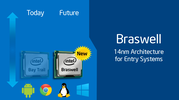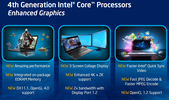Intel HD Graphics 400 (Braswell) vs Intel HD Graphics 4000 vs Intel HD Graphics 4400
Intel HD Graphics 400 (Braswell) ► remove from comparison
Die Intel HD Graphics 400 ist eine in den Low-End-SoCs der Braswell-Serie (z.B. Celeron Serie in 2016) integrierte Grafikeinheit. Sie basiert auf der gleichen Architektur wie die GPU verschiedener Broadwell-Prozessoren (z.B. HD Graphics 5300 ), bietet allerdings deutlich weniger Shadereinheiten und geringere Taktraten. Die genauen Spezifikationen hängen vom jeweiligen SoC ab: Die schnellste Variante bietet derzeit 12 EUs und maximal 640 MHz.
Anfangs wurde die GPU nur Intel HD Graphics benannt, später als Intel HD Graphics 400 (12 EU Version) und Intel HD Graphics 405 (16 EU Version) bezeichnet.
Anwender müssen sich deshalb insbesondere bei den Celeron-Modellen, die zusätzlich durch die Beschneidung auf nur zwei CPU-Kerne ausgebremst werden, auf ältere und anspruchslose Spiele beschränken. Videos werden dagegen auch in 4K/H.265 flüssig wiedergeben.
Für mehr Benchmarks besuchen sie auch die Seite der Intel HD Graphics (Braswell) GPU , welche Benchmarks der älteren baugleichen 12 und 16 EU Versionen beinhaltet.
Intel HD Graphics 4000 ► remove from comparison
Die Intel HD Graphics 4000 (GT2) ist eine Prozessorgrafikkarte in den CPUs der Ivy Bridge Generation (3. Generation von Intel Core z.B. Core i7-3770). Je nach Prozessormodell wird die Intel HD Graphics 4000 unterschiedlich getaktet (und kann auf den unterschiedlich großen Cache zurückgreifen) und bietet daher eine teilweise deutlich geringe Leistung. Weiterhin kann die Taktung durch die Turbo Boost Technologie je nach Anforderung und TDP deutlich erhöht werden. In den schnellen Modellen soll der Basistakt 650 MHz und der Turbo 1.1 bis 1.25 GHz betragen. Die ULV Modelle weisen jedoch einen deutlich geringeren Basistakt auf (Sandy Bridge z.B. 350 MHz).
Im Vergleich zur HD Graphics 3000 der Sandy Bridge Prozessoren, bietet die 4000er einen eigenen Cache, überarbeitete DirectX 11 taugliche Shader (und vier mehr) und soll dadurch bis zu 60% mehr Leistung (3DMark Vantage) zeigen. Weiterhin sollte die GPU auf den gemeinsamen Last Level Cache (Level 3 Cache) des Prozessors zugreifen können. Weiters können die Shader auch für Direct Compute genutzt werden.
Erste Benchmarks positionieren die HD Graphics 4000 (in einem schnellen Desktop Quad-Core) auf dem Level einer Nvidia GeForce GT 330M und dadurch oberhalb der integrierten Prozessorgrafik Radeon HD 6620G . In unserem Unfangreichen Testbericht der HD Graphics 4000 konnte sie sich im schnellen Core i7-3820QM deutlich durchsetzen (6620G 15% langsamer). In den Mittelklassemodellen Core i7-3610QM und einem Dual-Core i5 war sie nur noch knapp schneller. Manchmal ist sogar eine langsame GeForce GT 630M in Reichweite. Gelegenheitsspieler, die bei Bedarf mit einer geringen Auflösung, deaktivierter Kantenglättung und niedrigen Settings leben können, werden daher an der HD Graphics 4000 durchaus Gefallen finden. In den ULV Prozessoren (Core ix-3xx7U) wird eine geringer getaktete Variante eingesetzt. Durch die TDP Beschränkungen kann der Turbo außerdem meistens nicht so hoch takten, wie bei den 35/45 Watt Versionen. Dadurch ist die HD Graphics 4000 hier meist etwa 30% langsamer als in schnellen Quad-Core CPUs.
Eine Besonderheit der Ivy Bride Grafikkerne ist, das nur 4x MSAA von der Hardware unterstützt wird. 2x MSAA wird per Software berechnet und geht durch die 4x MSAA Pipeline. Daher empfiehlt sich der Einsatz des gleich schnellen 4x MSAA.
Auch der integrierte Videodecoder genannt Multi Format Codec Engine (MFX) wurde kräftig überarbeitet und soll nun sogar mehrere 4K Videos parallel dekodieren können (ev nur in den High-End Modellen). DXVA Checker gibt weiterhin die Formate MPEG2, VC1, WMV9 und H264 als unterstütz an. QuickSync zum schnellen Transkodieren von Videos wurde ebenfalls verbessert und soll nun schneller bei gleichzeitig höherer Qualität laufen.
Ebenfalls neu ist die Unterstützung für drei unabhängige Bildschirme (abhängig von der Umsetzung im Notebook eventuell nur zwei gleichzeitige möglich). Bis jetzt waren nur zwei möglich und lediglich die AMD Grafikkarten mit Eyefinity Support bieten mehr als zwei Anschlüsse für Notebooks (jedoch nur mit DisplayPorts). Laut Intel wird DisplayPort in der Version 1.1 unterstützt (daher maximal 2560x1600) und HDMI in 1.4 (in der Praxis 1920x1080, siehe Fokusartikel für 2560x1600 ).
Der Stromverbrauch ist dank des 22nm Prozesses mit 3D Tri-Gate Technologie relativ gering und nicht einzeln angegeben. Die Notebook-Prozessoren (CPU, GPU, Speichercontroller) sind gesamt auf einen TDP von 18-45 Watt spezifziert.
Intel HD Graphics 4400 ► remove from comparison
Die Intel HD Graphics 4400 (GT2) ist eine Prozessorgrafikkarte in einigen ULV-CPUs der Haswell Generation. Je nach Prozessormodell wird die Intel HD Graphics 4400 unterschiedlich getaktet und kann auf einen unterschiedlich großen Cache zurückgreifen. All dies sowie die Geschwindigkeit des angebundenen Arbeitsspeichers beeinflusst die Performance entscheidend. Im Vergleich zur HD 4600 bietet die HD 4400 gleich viele Shaderkerne, aber geringere Taktraten (siehe Taktratenliste der Modelle weiter unten).
Der Grafikkern wurde im Vergleich zum Intel HD Graphics 4000 der Ivy-Bridge-Generation in verschiedenen Punkten weiterentwickelt. So unterstützt die GPU nun mit DirectX 11.1, OpenCL 1.2 und OpenGL 4.0 alle wichtigen aktuellen Standards. Auch ein verbesserter Decoder für 4K-Videos sowie ein überarbeiteter Quick-Sync-Encoder sind mit an Bord.
Die Performance der HD Graphics 4400 liegt deutlich unter der HD 4600 , da die GPU in ULV-Modellen mit relativ geringer Taktrate eingesetzt wird. Desweiteren limitiert die niedrige TDP dieser Modelle den Turbo Boost, der oftmals nicht vollständig ausgeschöpft werden kann. Gegenüber der HD 4000 in den ULV-Modellen der Ivy-Bridge-Generation ist dennoch ein leichtes Leistungsplus zu verzeichnen. Neben architektonischen Verbesserungen ist dies vor allem auf eine gesteigerte Zahl an Ausführungseinheiten zurückzuführen: Die GT2-Ausbaustufe verfügt nun über 20 der sogenannten EUs (HD 4000: 16). Abhängig von der Taktrate erreicht die HD 4400 in etwa die Leistung einer dedizierten Radeon HD 7550M .
Der Stromverbrauch ist dank des 22-Nanometer-Prozesses mit Tri-Gate-Transistoren relativ gering und wird dynamisch vom TDP-Budget des gesamten Chips abgezweigt. Die HD 4400 kommt in einigen Dual-Core ULV-Prozessoren der 15-Watt-Klasse zum Einsatz.
Weitere Details zur Grafikkartenarchitektur der Haswell Generation, finden Sie in unserem Artikel von der IDF 2012 .
Intel HD Graphics 400 (Braswell) Intel HD Graphics 4000 Intel HD Graphics 4400 HD Graphics Serie Codename Braswell Ivy Bridge Haswell GT2 Architektur Gen. 8 Gen. 7 Ivy Bridge Gen. 7.5 Haswell Pipelines 12 - unified 16 - unified 20 - unified Kerntakt 320 - 640 (Boost) MHz 350 - 1350 (Boost) MHz 200 - 1100 (Boost) MHz Speicherbandbreite 64/128 Bit 64/128 Bit 64/128 Bit Shared Memory ja ja ja API DirectX 11.2, Shader 5.0 DirectX 11, Shader 5.0, OpenGL 3.1 DirectX 11.1, Shader 5.0, OpenGL 4.0 Herstellungsprozess 14 nm 22 nm 22 nm Erscheinungsdatum 01.04.2016 23.03.2011 05.06.2013 Features QuickSync QuickSync
CPU in HD Graphics 400 (Braswell) GPU Base Speed GPU Boost / Turbo Intel Atom x5-Z8550 4 x 1440 MHz 200 MHz 600 MHz Intel Celeron N3060 2 x 1600 MHz, 6 W 320 MHz 700 MHz min. - max. 200 - 320 MHz 600 - 700 MHz
CPU in HD Graphics 4000 GPU Base Speed GPU Boost / Turbo Intel Core i7-3770K 4 x 3500 MHz, 77 W 650 MHz 1150 MHz Intel Core i7-3940XM 4 x 3000 MHz, 55 W 650 MHz 1350 MHz Intel Core i7-3920XM 4 x 2900 MHz, 55 W 650 MHz 1300 MHz » show 36 more Intel Core i7-3840QM 4 x 2800 MHz, 45 W 650 MHz 1300 MHz Intel Core i7-3820QM 4 x 2700 MHz, 45 W 650 MHz 1250 MHz Intel Core i7-3740QM 4 x 2700 MHz, 45 W 650 MHz 1300 MHz Intel Core i7-3720QM 4 x 2600 MHz, 45 W 650 MHz 1250 MHz Intel Core i5-3570K 4 x 3400 MHz, 77 W 650 MHz 1150 MHz Intel Core i7-3635QM 4 x 2400 MHz, 45 W 650 MHz 1200 MHz Intel Core i7-3630QM 4 x 2400 MHz, 45 W 650 MHz 1150 MHz Intel Core i7-3615QM 4 x 2300 MHz, 45 W 650 MHz 1200 MHz Intel Core i7-3610QM 4 x 2300 MHz, 45 W 650 MHz 1100 MHz Intel Core i7-3632QM 4 x 2200 MHz, 35 W 650 MHz 1150 MHz Intel Core i7-3612QM 4 x 2100 MHz, 35 W 650 MHz 1100 MHz Intel Core i7-3540M 2 x 3000 MHz, 35 W 650 MHz 1300 MHz Intel Core i7-3520M 2 x 2900 MHz, 35 W 650 MHz 1250 MHz Intel Core i5-3380M 2 x 2900 MHz, 35 W 650 MHz 1250 MHz Intel Core i5-3360M 2 x 2800 MHz, 35 W 650 MHz 1200 MHz Intel Core i5-3340M 2 x 2700 MHz, 35 W 650 MHz 1250 MHz Intel Core i5-3320M 2 x 2600 MHz, 35 W 650 MHz 1200 MHz Intel Core i5-3230M 2 x 2600 MHz, 35 W 650 MHz 1100 MHz Intel Core i7-3687U 2 x 2100 MHz, 17 W 350 MHz 1200 MHz Intel Core i5-3210M 2 x 2500 MHz, 35 W 650 MHz 1100 MHz Intel Core i7-3667U 2 x 2000 MHz, 17 W 350 MHz 1150 MHz Intel Core i7-3537U 2 x 2000 MHz, 17 W 350 MHz 1200 MHz Intel Core i7-3517U 2 x 1900 MHz, 17 W 350 MHz 1150 MHz Intel Core i3-3130M 2 x 2600 MHz, 35 W 650 MHz 1100 MHz Intel Core i5-3437U 2 x 1900 MHz, 17 W 650 MHz 1200 MHz Intel Core i3-3120M 2 x 2500 MHz, 35 W 650 MHz 1100 MHz Intel Core i5-3427U 2 x 1800 MHz, 17 W 350 MHz 1150 MHz Intel Core i5-3337U 2 x 1800 MHz, 17 W 350 MHz 1100 MHz Intel Core i3-3110M 2 x 2400 MHz, 35 W 650 MHz 1000 MHz Intel Core i5-3317U 2 x 1700 MHz, 17 W 350 MHz 1050 MHz Intel Core i7-3689Y 2 x 1500 MHz, 13 W 350 MHz 850 MHz Intel Core i5-3439Y 2 x 1500 MHz, 13 W 350 MHz 850 MHz Intel Core i3-3227U 2 x 1900 MHz, 17 W 350 MHz 1100 MHz Intel Core i5-3339Y 2 x 1500 MHz, 13 W 350 MHz 850 MHz Intel Core i3-3217U 2 x 1800 MHz, 17 W 350 MHz 1050 MHz Intel Core i3-3229Y 2 x 1400 MHz, 13 W 350 MHz 850 MHz min. - max. 200 - 650 MHz 600 - 1350 MHz
CPU in HD Graphics 4400 GPU Base Speed GPU Boost / Turbo Intel Core i7-4600U 2 x 2100 MHz, 15 W 200 MHz 1100 MHz Intel Core i7-4510U 2 x 2000 MHz, 15 W 200 MHz 1100 MHz Intel Core i7-4500U 2 x 1800 MHz, 15 W 200 MHz 1100 MHz » show 10 more Intel Core i5-4310U 2 x 2000 MHz, 15 W 200 MHz 1100 MHz Intel Core i5-4300U 2 x 1900 MHz, 15 W 200 MHz 1100 MHz Intel Core i5-4210U 2 x 1700 MHz, 15 W 200 MHz 1000 MHz Intel Core i5-4200U 2 x 1600 MHz, 15 W 200 MHz 1000 MHz Intel Core i3-4120U 2 x 2000 MHz, 15 W 200 MHz 1000 MHz Intel Core i3-4030U 2 x 1900 MHz, 15 W 200 MHz 1000 MHz Intel Core i3-4025U 2 x 1900 MHz, 15 W 200 MHz 950 MHz Intel Core i3-4100U 2 x 1800 MHz, 15 W 200 MHz 1000 MHz Intel Core i3-4010U 2 x 1700 MHz, 15 W 200 MHz 1000 MHz Intel Core i3-4005U 2 x 1700 MHz, 15 W 200 MHz 950 MHz min. - max. 200 - 650 MHz 600 - 1350 MHz
Benchmarks Performance Rating - 3DMark 11 + Fire Strike + Time Spy - HD Graphics 400 (Braswell)
0.1 pt (0%)
Intel HD Graphics 400 (Braswell)
...
max:
Performance Rating - 3DMark 11 + Fire Strike + Time Spy - HD Graphics 4000
0.2 pt (1%)
...
...
max:
Performance Rating - 3DMark 11 + Fire Strike + Time Spy - HD Graphics 4400
0.3 pt (1%)
...
...
max:
3DMark - 3DMark Ice Storm Unlimited Graphics
min: 17968 avg: 20459 median: 20277 (2%) max: 23161 Points
min: 43759 avg: 44324 median: 44323.5 (5%) max: 44888 Points
37082 Points (4%)
3DMark - 3DMark Ice Storm Extreme Graphics
14334 Points (2%)
min: 20514 avg: 24179 median: 24426 (3%) max: 28772 Points
min: 19943 avg: 25546 median: 24573 (3%) max: 33095 Points
3DMark - 3DMark Cloud Gate Score
min: 1350 avg: 1553 median: 1457 (2%) max: 2087 Points
min: 1469 avg: 3380 median: 3282.5 (4%) max: 5946 Points
min: 1733 avg: 3980 median: 3940 (4%) max: 4989 Points
3DMark - 3DMark Cloud Gate Graphics
min: 1519 avg: 1865 median: 1841 (0%) max: 2455 Points
min: 1619 avg: 3850 median: 3768.5 (1%) max: 5761 Points
min: 1946 avg: 5040 median: 4953 (1%) max: 6547 Points
3DMark - 3DMark Fire Strike Standard Score
min: 176 avg: 188 median: 188 (0%) max: 200 Points
min: 168 avg: 446.5 median: 444 (1%) max: 647 Points
min: 352 avg: 543 median: 525 (1%) max: 700 Points
3DMark - 3DMark Fire Strike Standard Graphics
min: 202 avg: 218 median: 218 (0%) max: 234 Points
min: 191 avg: 486.1 median: 480 (1%) max: 705 Points
min: 369 avg: 592 median: 569 (1%) max: 778 Points
3DMark - 3DMark Ice Storm Graphics
min: 13689 avg: 18517 median: 18516.5 (2%) max: 23344 Points
min: 11232 avg: 31858 median: 31598 (4%) max: 48923 Points
min: 12866 avg: 38629 median: 38886.5 (5%) max: 58126 Points
3DMark - 3DMark Sling Shot (ES 3.0) Unlimited
min: 1502 avg: 1926 median: 1925.5 (8%) max: 2349 Points
3DMark - 3DMark Sling Shot (ES 3.0) Unlimited Graphics
min: 1452 avg: 2046 median: 2046 (4%) max: 2640 Points
3DMark - 3DMark Sling Shot Extreme (ES 3.1) Unlimited
1180 Points (6%)
3DMark - 3DMark Sling Shot Extreme (ES 3.1) Unlimited Graphics
977 Points (3%)
3DMark 11 - 3DM11 Performance Score
min: 289 avg: 386.1 median: 397 (1%) max: 478 Points
min: 248 avg: 603 median: 603 (1%) max: 802 Points
min: 460 avg: 843 median: 828 (1%) max: 1032 Points
3DMark 11 - 3DM11 Performance GPU
min: 247 avg: 341.1 median: 349 (0%) max: 418 Points
min: 216 avg: 522 median: 523 (0%) max: 684 Points
min: 399 avg: 755 median: 735.5 (1%) max: 962 Points
3DMark Vantage + Intel HD Graphics 4000 3DMark Vantage - 3DM Vant. Perf. total
min: 830 avg: 2985 median: 2959 (1%) max: 4433 Points
3DM Vant. Perf. total + Intel HD Graphics 4400
min: 2450 avg: 3559 median: 3583 (1%) max: 4820 Points
3DM Vant. Perf. GPU no PhysX + Intel HD Graphics 4000 3DMark Vantage - 3DM Vant. Perf. GPU no PhysX
min: 659 avg: 2441 median: 2415 (1%) max: 3488 Points
3DM Vant. Perf. GPU no PhysX + Intel HD Graphics 4400
min: 2083 avg: 3005 median: 2986.5 (2%) max: 4123 Points
3DMark 2001SE - 3DMark 2001 - Standard
min: 8967 avg: 14343 median: 15220 (16%) max: 16933 Points
20486 Points (21%)
3DMark 03 - 3DMark 03 - Standard
min: 7402 avg: 11805 median: 12768 (7%) max: 19294 Points
min: 9129 avg: 12378 median: 13244 (7%) max: 16040 Points
3DMark 05 - 3DMark 05 - Standard
min: 5239 avg: 8296 median: 8393 (9%) max: 11948 Points
min: 6313 avg: 8674 median: 8802 (10%) max: 10495 Points
3DMark 06 3DMark 06 - Standard 1280x1024 + Intel HD Graphics 400 (Braswell)
2474 Points (3%)
3DMark 06 - Standard 1280x1024 + Intel HD Graphics 4000
min: 1605 avg: 4588 median: 4412.5 (6%) max: 7159 Points
3DMark 06 - Standard 1280x1024 + Intel HD Graphics 4400
min: 4074 avg: 5110 median: 5164 (7%) max: 6293 Points
3DMark 06 - Score Unknown Settings + Intel HD Graphics 4000
4276 Points (6%)
Unigine Heaven 3.0 - Unigine Heaven 3.0 DX 11
min: 6.9 avg: 7.6 median: 7.4 (2%) max: 8.9 fps
min: 6.5 avg: 7.7 median: 8.2 (3%) max: 8.4 fps
Unigine Heaven 3.0 - Unigine Heaven 3.0 OpenGL
min: 7.7 avg: 8.1 median: 8.1 (4%) max: 8.4 fps
min: 7 avg: 8.2 median: 8.6 (4%) max: 9.1 fps
Unigine Heaven 2.1 - Heaven 2.1 high
min: 6 avg: 9.6 median: 9.4 (2%) max: 13 fps
min: 7.9 avg: 10.9 median: 10.9 (2%) max: 15.9 fps
SPECviewperf 11 + Intel HD Graphics 4000 SPECviewperf 11 - specvp11 snx-01
min: 0.69 avg: 1.1 median: 1.2 (1%) max: 1.47 fps
specvp11 snx-01 + Intel HD Graphics 4400
min: 1.06 avg: 1.6 median: 1.7 (1%) max: 2.09 fps
specvp11 tcvis-02 + Intel HD Graphics 4000 SPECviewperf 11 - specvp11 tcvis-02
min: 1.43 avg: 1.9 median: 2.1 (1%) max: 2.27 fps
specvp11 tcvis-02 + Intel HD Graphics 4400
min: 1.47 avg: 2.2 median: 2.2 (1%) max: 2.94 fps
specvp11 sw-02 + Intel HD Graphics 4000 SPECviewperf 11 - specvp11 sw-02
min: 3.98 avg: 6.9 median: 7.5 (6%) max: 8.45 fps
specvp11 sw-02 + Intel HD Graphics 4400
min: 6.04 avg: 9.7 median: 9.6 (7%) max: 12.19 fps
specvp11 proe-05 + Intel HD Graphics 4000 SPECviewperf 11 - specvp11 proe-05
min: 0.62 avg: 1.1 median: 1.2 (1%) max: 1.47 fps
specvp11 proe-05 + Intel HD Graphics 4400
min: 1.39 avg: 1.8 median: 1.9 (2%) max: 2.28 fps
specvp11 maya-03 + Intel HD Graphics 4000 SPECviewperf 11 - specvp11 maya-03
min: 7.12 avg: 10.2 median: 9.7 (7%) max: 13.09 fps
specvp11 maya-03 + Intel HD Graphics 4400
min: 7.81 avg: 12.6 median: 12.2 (9%) max: 16.81 fps
specvp11 lightwave-01 + Intel HD Graphics 4000 SPECviewperf 11 - specvp11 lightwave-01
min: 5.67 avg: 10.2 median: 11.1 (12%) max: 12.55 fps
specvp11 lightwave-01 + Intel HD Graphics 4400
min: 9.88 avg: 13.6 median: 13.2 (14%) max: 17.4 fps
specvp11 ensight-04 + Intel HD Graphics 4000 SPECviewperf 11 - specvp11 ensight-04
min: 1.06 avg: 1.6 median: 1.7 (1%) max: 2.24 fps
specvp11 ensight-04 + Intel HD Graphics 4400
min: 1.29 avg: 1.9 median: 2 (1%) max: 2.47 fps
specvp11 catia-03 + Intel HD Graphics 4000 SPECviewperf 11 - specvp11 catia-03
0 fps (0%)
SPECviewperf 12 + Intel HD Graphics 4400 SPECviewperf 12 - specvp12 sw-03
min: 6.92 avg: 9.3 median: 9.3 (2%) max: 11.62 fps
specvp12 snx-02 + Intel HD Graphics 4400 SPECviewperf 12 - specvp12 snx-02
min: 1.99 avg: 2 median: 2 (0%) max: 2.08 fps
specvp12 showcase-01 + Intel HD Graphics 4400 SPECviewperf 12 - specvp12 showcase-01
min: 4.19 avg: 4.3 median: 4.3 (1%) max: 4.48 fps
specvp12 mediacal-01 + Intel HD Graphics 4400 SPECviewperf 12 - specvp12 mediacal-01
min: 1.24 avg: 1.5 median: 1.5 (0%) max: 1.84 fps
specvp12 maya-04 + Intel HD Graphics 4400 SPECviewperf 12 - specvp12 maya-04
min: 2.36 avg: 2.5 median: 2.5 (1%) max: 2.54 fps
specvp12 energy-01 + Intel HD Graphics 4400 SPECviewperf 12 - specvp12 energy-01
min: 0.07 avg: 0.1 median: 0.1 (0%) max: 0.22 fps
specvp12 creo-01 + Intel HD Graphics 4400 SPECviewperf 12 - specvp12 creo-01
min: 6.08 avg: 6.6 median: 6.6 (3%) max: 7.02 fps
specvp12 catia-04 + Intel HD Graphics 4400 SPECviewperf 12 - specvp12 catia-04
min: 7.96 avg: 8.3 median: 8.3 (1%) max: 8.54 fps
Windows 7 Experience Index - Win7 Gaming graphics
min: 5.9 avg: 6.4 median: 6.4 (81%) max: 6.6 Points
min: 5.2 avg: 6.2 median: 6.5 (82%) max: 6.5 Points
Windows 7 Experience Index - Win7 Graphics
min: 4.7 avg: 5.6 median: 5.1 (65%) max: 6.6 Points
min: 5.2 avg: 5.5 median: 5.2 (66%) max: 6.5 Points
Cinebench R10 Cinebench R10 Shading (32bit) + Intel HD Graphics 400 (Braswell) Cinebench R10 - Cinebench R10 Shading (32bit)
min: 1627 avg: 2057 median: 2052.5 (1%) max: 2510 Points
Cinebench R10 Shading (32bit) + Intel HD Graphics 4000
min: 2447 avg: 5020 median: 5157 (4%) max: 8562 Points
Cinebench R10 Shading (32bit) + Intel HD Graphics 4400
min: 4094 avg: 6063 median: 6130 (4%) max: 8532 Points
Cinebench R11.5 Cinebench R11.5 OpenGL 64 Bit + Intel HD Graphics 400 (Braswell) Cinebench R11.5 - Cinebench R11.5 OpenGL 64 Bit
min: 9.97 avg: 10.1 median: 10 (3%) max: 10.12 fps
Cinebench R11.5 OpenGL 64 Bit + Intel HD Graphics 4000
min: 5.58 avg: 14.4 median: 13.6 (5%) max: 22.54 fps
Cinebench R11.5 OpenGL 64 Bit + Intel HD Graphics 4400
min: 9.45 avg: 16.8 median: 16.4 (6%) max: 24 fps
Cinebench R15 + Intel HD Graphics 400 (Braswell) Cinebench R15 - Cinebench R15 OpenGL 64 Bit
min: 8.48 avg: 11 median: 11.3 (1%) max: 13.98 fps
Cinebench R15 OpenGL 64 Bit + Intel HD Graphics 4000
min: 8.47 avg: 11.9 median: 11.9 (1%) max: 15.35 fps
Cinebench R15 OpenGL 64 Bit + Intel HD Graphics 4400
min: 12.87 avg: 20.3 median: 20.4 (1%) max: 26.49 fps
Cinebench R15 OpenGL Ref. Match 64 Bit + Intel HD Graphics 400 (Braswell) Cinebench R15 - Cinebench R15 OpenGL Ref. Match 64 Bit
98 % (98%)
Cinebench R15 OpenGL Ref. Match 64 Bit + Intel HD Graphics 4000
min: 32.2 avg: 50.9 median: 32.2 (32%) max: 97.8 %
Cinebench R15 OpenGL Ref. Match 64 Bit + Intel HD Graphics 4400
min: 2.87 avg: 88.2 median: 98 (98%) max: 98 %
GFXBench - GFXBench 5.0 Aztec Ruins High Tier Offscreen
3.3 fps (1%)
GFXBench - GFXBench 5.0 Aztec Ruins Normal Tier Offscreen
9.3 fps (1%)
GFXBench 3.1 - GFXBench Manhattan ES 3.1 Offscreen
min: 7.2 avg: 10.6 median: 10.6 (0%) max: 14 fps
GFXBench 3.0 - GFXBench 3.0 Manhattan Offscreen
min: 14 avg: 16 median: 16 (1%) max: 18 fps
16.2 fps (1%)
GFXBench (DX / GLBenchmark) 2.7 + Intel HD Graphics 400 (Braswell) GFXBench (DX / GLBenchmark) 2.7 - GFXBench T-Rex HD Offscreen C24Z16
min: 27 avg: 29 median: 29 (0%) max: 31 fps
GFXBench T-Rex HD Offscreen C24Z16 + Intel HD Graphics 4000 min: 31 avg: 40.1 median: 39 (0%) max: 49 fps
GFXBench T-Rex HD Offscreen C24Z16 + Intel HD Graphics 4400 min: 57 avg: 60.5 median: 60.5 (0%) max: 64 fps
LuxMark v2.0 64Bit - LuxMark v2.0 Room GPU
min: 31 avg: 46.9 median: 34 (0%) max: 163 Samples/s
min: 117 avg: 154.1 median: 150 (1%) max: 222 Samples/s
LuxMark v2.0 64Bit - LuxMark v2.0 Sala GPU
min: 50 avg: 79.4 median: 66 (0%) max: 251 Samples/s
min: 143 avg: 227.5 median: 234 (0%) max: 293 Samples/s
ComputeMark v2.1 - ComputeMark v2.1 Result
min: 31 avg: 514 median: 537 (1%) max: 630 Points
min: 384 avg: 542 median: 575 (1%) max: 613 Points
Average Benchmarks Intel HD Graphics 400 (Braswell) → 100% n=15 Average Benchmarks Intel HD Graphics 4000 → 172% n=15 Average Benchmarks Intel HD Graphics 4400 → 215% n=15
- Bereich der Benchmarkergebnisse für diese Grafikkarte
- Durchschnittliche Benchmarkergebnisse für diese Grafikkarte
* Smaller numbers mean a higher performance
1 This benchmark is not used for the average calculation
Spiele-Benchmarks Die folgenden Benchmarks basieren auf unseren Spieletests mit Testnotebooks. Die Performance dieser Grafikkarte bei den gelisteten Spielen ist abhängig von der verwendeten CPU, Speicherausstattung, Treiber und auch Betriebssystem. Dadurch müssen die untenstehenden Werte nicht repräsentativ sein. Detaillierte Informationen über das verwendete System sehen Sie nach einem Klick auf den fps-Wert.
HD Graphics 4400:
9 [X] HP Probook 470 G2 G6W69EA Intel Core i7-4510U 2GHz
HD Graphics 4400
fps
HD Graphics 4400:
8.1 [X] HP Probook 470 G2 G6W69EA Intel Core i7-4510U 2GHz
HD Graphics 4400
fps
HD Graphics 4400:
8.8 [X] HP Probook 470 G2 G6W69EA Intel Core i7-4510U 2GHz
HD Graphics 4400
fps
HD Graphics 4400:
4.1 [X] HP Probook 470 G2 G6W69EA Intel Core i7-4510U 2GHz
HD Graphics 4400
fps
HD Graphics 4400:
7.9 [X] HP Probook 470 G2 G6W69EA Intel Core i7-4510U 2GHz
HD Graphics 4400
fps
HD Graphics 4400:
25.3 [X] HP Probook 470 G2 G6W69EA Intel Core i7-4510U 2GHz
HD Graphics 4400
fps
HD Graphics 4400:
8 [X] HP Probook 470 G2 G6W69EA Intel Core i7-4510U 2GHz
HD Graphics 4400
fps
HD Graphics 4400:
7.4 [X] HP Probook 470 G2 G6W69EA Intel Core i7-4510U 2GHz
HD Graphics 4400
fps
HD Graphics 4400:
11 [X] HP Probook 470 G2 G6W69EA Intel Core i7-4510U 2GHz
HD Graphics 4400
fps
HD Graphics 4400:
10.3 [X] HP Probook 470 G2 G6W69EA Intel Core i7-4510U 2GHz
HD Graphics 4400
min:
9 fps, max:
11 fps
fps
HD Graphics 4400:
8.3 [X] HP Probook 470 G2 G6W69EA Intel Core i7-4510U 2GHz
HD Graphics 4400
fps
HD Graphics 4400:
10 [X] HP Probook 470 G2 G6W69EA Intel Core i7-4510U 2GHz
HD Graphics 4400
fps
HD Graphics 4400:
20 [X] HP Probook 470 G2 G6W69EA Intel Core i7-4510U 2GHz
HD Graphics 4400
fps
HD Graphics 4400:
4 [X] HP Probook 470 G2 G6W69EA Intel Core i7-4510U 2GHz
HD Graphics 4400
fps
HD Graphics 4400:
8 [X] HP Probook 470 G2 G6W69EA Intel Core i7-4510U 2GHz
HD Graphics 4400
fps
HD Graphics 4400:
4 [X] HP Probook 470 G2 G6W69EA Intel Core i7-4510U 2GHz
HD Graphics 4400
fps
HD Graphics 4400:
15 [X] HP Probook 470 G2 G6W69EA Intel Core i7-4510U 2GHz
HD Graphics 4400
fps
HD Graphics 4400:
7.4 [X] HP Probook 470 G2 G6W69EA Intel Core i7-4510U 2GHz
HD Graphics 4400
fps
HD Graphics 4400:
15 [X] HP Probook 470 G2 G6W69EA Intel Core i7-4510U 2GHz
HD Graphics 4400
fps
HD Graphics 4400:
10.4 [X] HP Probook 470 G2 G6W69EA Intel Core i7-4510U 2GHz
HD Graphics 4400
fps
100%
HD Graphics 400 (Braswell):
14.1 fps
204%
HD Graphics 4400:
28.8 [X] HP Probook 470 G2 G6W69EA Intel Core i7-4510U 2GHz
HD Graphics 4400
fps
HD Graphics 4400:
10.3 [X] HP Probook 470 G2 G6W69EA Intel Core i7-4510U 2GHz
HD Graphics 4400
fps
HD Graphics 4400:
9.2 [X] HP Probook 470 G2 G6W69EA Intel Core i7-4510U 2GHz
HD Graphics 4400
fps
HD Graphics 4400:
7.1 [X] HP Probook 470 G2 G6W69EA Intel Core i7-4510U 2GHz
HD Graphics 4400
fps
HD Graphics 4400:
10.1 [X] HP Probook 470 G2 G6W69EA Intel Core i7-4510U 2GHz
HD Graphics 4400
fps
HD Graphics 4400:
4 [X] HP Probook 470 G2 G6W69EA Intel Core i7-4510U 2GHz
HD Graphics 4400
fps
HD Graphics 4400:
5 [X] HP Probook 470 G2 G6W69EA Intel Core i7-4510U 2GHz
HD Graphics 4400
fps
HD Graphics 4400:
30.4 [X] HP Probook 470 G2 G6W69EA Intel Core i7-4510U 2GHz
HD Graphics 4400
fps
HD Graphics 4400:
7 [X] HP Probook 470 G2 G6W69EA Intel Core i7-4510U 2GHz
HD Graphics 4400
fps
HD Graphics 4400:
12 [X] HP Probook 470 G2 G6W69EA Intel Core i7-4510U 2GHz
HD Graphics 4400
fps
HD Graphics 4400:
7.9 [X] HP Probook 470 G2 G6W69EA Intel Core i7-4510U 2GHz
HD Graphics 4400
fps
HD Graphics 4400:
6.9 [X] HP Probook 470 G2 G6W69EA Intel Core i7-4510U 2GHz
HD Graphics 4400
fps
HD Graphics 4400:
5 [X] HP Probook 470 G2 G6W69EA Intel Core i7-4510U 2GHz
HD Graphics 4400
fps
HD Graphics 4400:
84.2 [X] HP Probook 470 G2 G6W69EA Intel Core i7-4510U 2GHz
HD Graphics 4400
fps
HD Graphics 4400:
9.6 [X] HP Probook 470 G2 G6W69EA Intel Core i7-4510U 2GHz
HD Graphics 4400
fps
HD Graphics 4400:
13.6 [X] HP Probook 470 G2 G6W69EA Intel Core i7-4510U 2GHz
HD Graphics 4400
fps
HD Graphics 4400:
10.8 [X] HP Probook 470 G2 G6W69EA Intel Core i7-4510U 2GHz
HD Graphics 4400
fps
HD Graphics 4400:
9.1 [X] HP Probook 470 G2 G6W69EA Intel Core i7-4510U 2GHz
HD Graphics 4400
fps
HD Graphics 4400:
46.5 [X] HP Probook 470 G2 G6W69EA Intel Core i7-4510U 2GHz
HD Graphics 4400
fps
HD Graphics 4400:
11 [X] HP Probook 470 G2 G6W69EA Intel Core i7-4510U 2GHz
HD Graphics 4400
fps
HD Graphics 4400:
9.6 [X] HP Probook 470 G2 G6W69EA Intel Core i7-4510U 2GHz
HD Graphics 4400
fps
HD Graphics 4400:
11.5 [X] HP Probook 470 G2 G6W69EA Intel Core i7-4510U 2GHz
HD Graphics 4400
fps
HD Graphics 4400:
5 [X] HP Probook 470 G2 G6W69EA Intel Core i7-4510U 2GHz
HD Graphics 4400
fps
HD Graphics 4400:
10 [X] HP Probook 470 G2 G6W69EA Intel Core i7-4510U 2GHz
HD Graphics 4400
fps
HD Graphics 4400:
8 [X] HP Probook 470 G2 G6W69EA Intel Core i7-4510U 2GHz
HD Graphics 4400
fps
HD Graphics 4400:
7 [X] HP Probook 470 G2 G6W69EA Intel Core i7-4510U 2GHz
HD Graphics 4400
fps
HD Graphics 4400:
13 [X] HP Probook 470 G2 G6W69EA Intel Core i7-4510U 2GHz
HD Graphics 4400
fps
HD Graphics 4400:
38.9 [X] HP Probook 470 G2 G6W69EA Intel Core i7-4510U 2GHz
HD Graphics 4400
fps
HD Graphics 4400:
7 [X] HP Probook 470 G2 G6W69EA Intel Core i7-4510U 2GHz
HD Graphics 4400
fps
HD Graphics 4400:
18 [X] HP Probook 470 G2 G6W69EA Intel Core i7-4510U 2GHz
HD Graphics 4400
fps
HD Graphics 4400:
13 [X] HP Probook 470 G2 G6W69EA Intel Core i7-4510U 2GHz
HD Graphics 4400
fps
HD Graphics 4400:
22.6 [X] HP Probook 470 G2 G6W69EA Intel Core i7-4510U 2GHz
HD Graphics 4400
fps
100%
HD Graphics 400 (Braswell):
18.5 fps
368%
HD Graphics 4000:
68 [X] Asus N56VM Intel Core i7-3720QM 2.6GHz
HD Graphics 4000
min:
63 fps
fps
243%
HD Graphics 4400:
45 [X] HP Probook 470 G2 G6W69EA Intel Core i7-4510U 2GHz
HD Graphics 4400
fps
100%
HD Graphics 400 (Braswell):
16 fps
250%
HD Graphics 4400:
40 [X] HP Probook 470 G2 G6W69EA Intel Core i7-4510U 2GHz
HD Graphics 4400
fps
HD Graphics 4000:
13.3 [X] Asus N56VM Intel Core i7-3720QM 2.6GHz
HD Graphics 4000
fps
HD Graphics 4400:
21.2 [X] HP Probook 470 G2 G6W69EA Intel Core i7-4510U 2GHz
HD Graphics 4400
fps
HD Graphics 4400:
8 [X] HP Probook 470 G2 G6W69EA Intel Core i7-4510U 2GHz
HD Graphics 4400
fps
100%
HD Graphics 400 (Braswell):
12.7 fps
514%
HD Graphics 4400:
65.3 [X] HP Probook 470 G2 G6W69EA Intel Core i7-4510U 2GHz
HD Graphics 4400
fps
HD Graphics 4400:
19.3 [X] HP Probook 470 G2 G6W69EA Intel Core i7-4510U 2GHz
HD Graphics 4400
fps
100%
HD Graphics 400 (Braswell):
6.8 fps
190%
HD Graphics 4400:
12.9 [X] HP Probook 470 G2 G6W69EA Intel Core i7-4510U 2GHz
HD Graphics 4400
fps
HD Graphics 4400:
5.6 [X] HP Probook 470 G2 G6W69EA Intel Core i7-4510U 2GHz
HD Graphics 4400
fps
HD Graphics 4400:
13.4 [X] HP Probook 470 G2 G6W69EA Intel Core i7-4510U 2GHz
HD Graphics 4400
fps
HD Graphics 4400:
10 [X] HP Probook 470 G2 G6W69EA Intel Core i7-4510U 2GHz
HD Graphics 4400
fps
HD Graphics 4400:
10.1 [X] HP Probook 470 G2 G6W69EA Intel Core i7-4510U 2GHz
HD Graphics 4400
fps
HD Graphics 4400:
13.1 [X] HP Probook 470 G2 G6W69EA Intel Core i7-4510U 2GHz
HD Graphics 4400
fps
100%
HD Graphics 400 (Braswell):
10.7 fps
207%
HD Graphics 4400:
22.1 [X] HP Probook 470 G2 G6W69EA Intel Core i7-4510U 2GHz
HD Graphics 4400
fps
HD Graphics 4400:
9.6 [X] HP Probook 470 G2 G6W69EA Intel Core i7-4510U 2GHz
HD Graphics 4400
fps
HD Graphics 4400:
8.4 [X] HP Probook 470 G2 G6W69EA Intel Core i7-4510U 2GHz
HD Graphics 4400
fps
HD Graphics 4400:
19.5 [X] HP Probook 470 G2 G6W69EA Intel Core i7-4510U 2GHz
HD Graphics 4400
fps
HD Graphics 4400:
12.7 [X] HP Probook 470 G2 G6W69EA Intel Core i7-4510U 2GHz
HD Graphics 4400
fps
100%
HD Graphics 400 (Braswell):
20.9 fps
206%
HD Graphics 4000:
43 [X] Asus N56VM Intel Core i7-3720QM 2.6GHz
HD Graphics 4000
min:
39 fps, max:
51 fps
fps
236%
HD Graphics 4400:
49.3 [X] HP Probook 470 G2 G6W69EA Intel Core i7-4510U 2GHz
HD Graphics 4400
fps
100%
HD Graphics 400 (Braswell):
5.8 fps
433%
HD Graphics 4000:
25.1 [X] Asus N56VM Intel Core i7-3720QM 2.6GHz
HD Graphics 4000
min:
23 fps, max:
30 fps
fps
467%
HD Graphics 4400:
27.1 [X] HP Probook 470 G2 G6W69EA Intel Core i7-4510U 2GHz
HD Graphics 4400
fps
HD Graphics 4400:
8.2 [X] HP Probook 470 G2 G6W69EA Intel Core i7-4510U 2GHz
HD Graphics 4400
fps
HD Graphics 4400:
14.1 [X] HP Probook 470 G2 G6W69EA Intel Core i7-4510U 2GHz
HD Graphics 4400
fps
HD Graphics 4400:
9 [X] HP Probook 470 G2 G6W69EA Intel Core i7-4510U 2GHz
HD Graphics 4400
fps
100%
HD Graphics 400 (Braswell):
9.7 fps
209%
HD Graphics 4400:
20.3 [X] HP Probook 470 G2 G6W69EA Intel Core i7-4510U 2GHz
HD Graphics 4400
fps
HD Graphics 4400:
7.5 [X] HP Probook 470 G2 G6W69EA Intel Core i7-4510U 2GHz
HD Graphics 4400
fps
HD Graphics 4400:
3.8 [X] HP Probook 470 G2 G6W69EA Intel Core i7-4510U 2GHz
HD Graphics 4400
fps
HD Graphics 4400:
33.9 [X] HP Probook 470 G2 G6W69EA Intel Core i7-4510U 2GHz
HD Graphics 4400
fps
HD Graphics 4400:
22.3 [X] HP Probook 470 G2 G6W69EA Intel Core i7-4510U 2GHz
HD Graphics 4400
fps
HD Graphics 4400:
12.8 [X] HP Probook 470 G2 G6W69EA Intel Core i7-4510U 2GHz
HD Graphics 4400
fps
HD Graphics 4400:
8.2 [X] HP Probook 470 G2 G6W69EA Intel Core i7-4510U 2GHz
HD Graphics 4400
fps
HD Graphics 4000:
0 (!) [X] Asus N56VM Intel Core i7-3720QM 2.6GHz
HD Graphics 4000
fps
HD Graphics 4400:
20.7 [X] Lenovo B50-70 MCC2GGE Intel Core i3-4030U 1.9GHz
HD Graphics 4400
fps
HD Graphics 4400:
10.3 [X] Lenovo B50-70 MCC2GGE Intel Core i3-4030U 1.9GHz
HD Graphics 4400
fps
100%
HD Graphics 400 (Braswell):
15 15.1 ~ 15 fps
171%
HD Graphics 4000:
25.6 [X] Asus N56VM Intel Core i7-3720QM 2.6GHz
HD Graphics 4000
min:
19 fps, max:
31 fps
fps
209%
HD Graphics 4400:
31.3 [X] HP Probook 470 G2 G6W69EA Intel Core i7-4510U 2GHz
HD Graphics 4400
fps
100%
HD Graphics 400 (Braswell):
9.5 9.7 ~ 10 fps
204%
HD Graphics 4400:
20.4 [X] HP Probook 470 G2 G6W69EA Intel Core i7-4510U 2GHz
HD Graphics 4400
fps
HD Graphics 4400:
8.5 [X] Lenovo B50-70 MCC2GGE Intel Core i3-4030U 1.9GHz
HD Graphics 4400
fps
HD Graphics 4400:
5.9 [X] Lenovo B50-70 MCC2GGE Intel Core i3-4030U 1.9GHz
HD Graphics 4400
fps
HD Graphics 4400:
14.2 [X] Lenovo B50-70 MCC2GGE Intel Core i3-4030U 1.9GHz
HD Graphics 4400
fps
HD Graphics 4400:
7.9 [X] Lenovo B50-70 MCC2GGE Intel Core i3-4030U 1.9GHz
HD Graphics 4400
fps
HD Graphics 4400:
12 [X] Lenovo B50-70 MCC2GGE Intel Core i3-4030U 1.9GHz
HD Graphics 4400
fps
HD Graphics 4400:
13.1 [X] Lenovo B50-70 MCC2GGE Intel Core i3-4030U 1.9GHz
HD Graphics 4400
fps
100%
HD Graphics 400 (Braswell):
5.3 fps
189%
HD Graphics 4000:
10 [X] Asus N56VM Intel Core i7-3720QM 2.6GHz
HD Graphics 4000
min:
9 fps, max:
11 fps
fps
247%
HD Graphics 4400:
13.1 [X] Lenovo B50-70 MCC2GGE Intel Core i3-4030U 1.9GHz
HD Graphics 4400
fps
HD Graphics 4400:
7.6 [X] Lenovo B50-70 MCC2GGE Intel Core i3-4030U 1.9GHz
HD Graphics 4400
fps
100%
HD Graphics 400 (Braswell):
7.3 fps
277%
HD Graphics 4400:
20.2 [X] Lenovo B50-70 MCC2GGE Intel Core i3-4030U 1.9GHz
HD Graphics 4400
fps
100%
HD Graphics 400 (Braswell):
3.2 fps
394%
HD Graphics 4400:
12.6 [X] Lenovo B50-70 MCC2GGE Intel Core i3-4030U 1.9GHz
HD Graphics 4400
fps
HD Graphics 4400:
17.6 [X] Lenovo B50-70 MCC2GGE Intel Core i3-4030U 1.9GHz
HD Graphics 4400
fps
HD Graphics 4400:
14.5 [X] Lenovo B50-70 MCC2GGE Intel Core i3-4030U 1.9GHz
HD Graphics 4400
fps
HD Graphics 4400:
24.9 [X] Lenovo B50-70 MCC2GGE Intel Core i3-4030U 1.9GHz
HD Graphics 4400
fps
HD Graphics 4400:
14.3 [X] Lenovo B50-70 MCC2GGE Intel Core i3-4030U 1.9GHz
HD Graphics 4400
fps
HD Graphics 4400:
4.7 [X] HP Probook 470 G2 G6W69EA Intel Core i7-4510U 2GHz
HD Graphics 4400
fps
HD Graphics 4400:
20.3 [X] Lenovo B50-70 MCC2GGE Intel Core i3-4030U 1.9GHz
HD Graphics 4400
fps
HD Graphics 4400:
12.1 [X] Lenovo B50-70 MCC2GGE Intel Core i3-4030U 1.9GHz
HD Graphics 4400
fps
HD Graphics 4400:
21 [X] Lenovo B50-70 MCC2GGE Intel Core i3-4030U 1.9GHz
HD Graphics 4400
fps
HD Graphics 4400:
9.2 [X] Lenovo B50-70 MCC2GGE Intel Core i3-4030U 1.9GHz
HD Graphics 4400
fps
100%
HD Graphics 400 (Braswell):
36.5 fps
164%
HD Graphics 4000:
60 [X] Asus N56VM Intel Core i7-3720QM 2.6GHz
HD Graphics 4000
min:
53 fps, max:
62 fps
fps
136%
HD Graphics 4400:
49.7 [X] Lenovo B50-70 MCC2GGE Intel Core i3-4030U 1.9GHz
HD Graphics 4400
fps
100%
HD Graphics 400 (Braswell):
14.2 fps
183%
HD Graphics 4000:
26 [X] Asus N56VM Intel Core i7-3720QM 2.6GHz
HD Graphics 4000
min:
23 fps, max:
30 fps
fps
178%
HD Graphics 4400:
25.3 [X] Lenovo B50-70 MCC2GGE Intel Core i3-4030U 1.9GHz
HD Graphics 4400
fps
100%
HD Graphics 400 (Braswell):
9 fps
178%
HD Graphics 4000:
16 [X] Asus N56VM Intel Core i7-3720QM 2.6GHz
HD Graphics 4000
min:
13 fps, max:
18 fps
fps
100%
HD Graphics 400 (Braswell):
13 fps
436%
HD Graphics 4000:
56.7 [X] Asus N56VM Intel Core i7-3720QM 2.6GHz
HD Graphics 4000
min:
44 fps, max:
71 fps
fps
335%
HD Graphics 4400:
43.6 [X] Lenovo B50-70 MCC2GGE Intel Core i3-4030U 1.9GHz
HD Graphics 4400
fps
100%
HD Graphics 400 (Braswell):
8 fps
450%
HD Graphics 4000:
36 [X] Asus N56VM Intel Core i7-3720QM 2.6GHz
HD Graphics 4000
min:
25 fps, max:
48 fps
fps
390%
HD Graphics 4400:
31.2 [X] Lenovo B50-70 MCC2GGE Intel Core i3-4030U 1.9GHz
HD Graphics 4400
fps
HD Graphics 4000:
17.1 [X] Asus N56VM Intel Core i7-3720QM 2.6GHz
HD Graphics 4000
min:
11 fps, max:
26 fps
fps
HD Graphics 4000:
12.4 [X] Asus N56VM Intel Core i7-3720QM 2.6GHz
HD Graphics 4000
min:
7 fps, max:
20 fps
fps
100%
HD Graphics 400 (Braswell):
13.3 fps
308%
HD Graphics 4000:
41 [X] Asus N56VM Intel Core i7-3720QM 2.6GHz
HD Graphics 4000
min:
37 fps, max:
45 fps
fps
265%
HD Graphics 4400:
35.2 [X] Lenovo B50-70 MCC2GGE Intel Core i3-4030U 1.9GHz
HD Graphics 4400
fps
HD Graphics 4000:
25.2 [X] Asus N56VM Intel Core i7-3720QM 2.6GHz
HD Graphics 4000
min:
24 fps, max:
27 fps
fps
HD Graphics 4400:
23.5 [X] Lenovo B50-70 MCC2GGE Intel Core i3-4030U 1.9GHz
HD Graphics 4400
fps
HD Graphics 4000:
9.6 [X] Asus N56VM Intel Core i7-3720QM 2.6GHz
HD Graphics 4000
min:
7 fps, max:
12 fps
fps
HD Graphics 4000:
14.6 [X] Asus N56VM Intel Core i7-3720QM 2.6GHz
HD Graphics 4000
min:
8 fps, max:
20 fps
fps
100%
HD Graphics 400 (Braswell):
21.3 fps
451%
HD Graphics 4000:
96 [X] Asus N56VM Intel Core i7-3720QM 2.6GHz
HD Graphics 4000
min:
81 fps
fps
283%
HD Graphics 4400:
60.3 [X] HP Probook 470 G2 G6W69EA Intel Core i7-4510U 2GHz
HD Graphics 4400
fps
100%
HD Graphics 400 (Braswell):
11.4 fps
353%
HD Graphics 4000:
40.2 [X] Asus N56VM Intel Core i7-3720QM 2.6GHz
HD Graphics 4000
min:
36 fps
fps
276%
HD Graphics 4400:
31.5 [X] HP Probook 470 G2 G6W69EA Intel Core i7-4510U 2GHz
HD Graphics 4400
fps
HD Graphics 4000:
16.9 [X] Asus N56VM Intel Core i7-3720QM 2.6GHz
HD Graphics 4000
min:
14 fps
fps
HD Graphics 4400:
14.5 [X] HP Probook 470 G2 G6W69EA Intel Core i7-4510U 2GHz
HD Graphics 4400
fps
100%
HD Graphics 400 (Braswell):
8.5 fps
126%
HD Graphics 4400:
10.7 [X] Lenovo B50-70 MCC2GGE Intel Core i3-4030U 1.9GHz
HD Graphics 4400
fps
100%
HD Graphics 400 (Braswell):
5.6 fps
123%
HD Graphics 4400:
6.9 [X] Lenovo B50-70 MCC2GGE Intel Core i3-4030U 1.9GHz
HD Graphics 4400
fps
100%
HD Graphics 400 (Braswell):
40.1 fps
180%
HD Graphics 4000:
53.7 91 (!) [X] Asus N56VM Intel Core i7-3720QM 2.6GHz
HD Graphics 4000
min:
66 fps, max:
128 fps
~ 72 fps
194%
HD Graphics 4400:
77.8 [X] Lenovo B50-70 MCC2GGE Intel Core i3-4030U 1.9GHz
HD Graphics 4400
fps
100%
HD Graphics 400 (Braswell):
11.7 fps
162%
HD Graphics 4000:
16.4 21 [X] Asus N56VM Intel Core i7-3720QM 2.6GHz
HD Graphics 4000
min:
15 fps, max:
27 fps
~ 19 fps
168%
HD Graphics 4400:
19.6 [X] Lenovo B50-70 MCC2GGE Intel Core i3-4030U 1.9GHz
HD Graphics 4400
fps
HD Graphics 4000:
12.5 12.6 [X] Asus N56VM Intel Core i7-3720QM 2.6GHz
HD Graphics 4000
min:
12.5 fps, max:
15.2 fps
~ 13 fps
HD Graphics 4000:
12.5 fps
100%
HD Graphics 400 (Braswell):
14.3 fps
187%
HD Graphics 4000:
26.8 [X] Asus N56VM Intel Core i7-3720QM 2.6GHz
HD Graphics 4000
min:
5 fps, max:
81 fps
fps
159%
HD Graphics 4400:
22.8 [X] HP Probook 470 G2 G6W69EA Intel Core i7-4510U 2GHz
HD Graphics 4400
fps
HD Graphics 4400:
17.8 [X] HP Probook 470 G2 G6W69EA Intel Core i7-4510U 2GHz
HD Graphics 4400
fps
HD Graphics 4000:
21.2 [X] Asus N56VM Intel Core i7-3720QM 2.6GHz
HD Graphics 4000
min:
10 fps, max:
33 fps
fps
HD Graphics 4400:
29.3 [X] Lenovo B50-70 MCC2GGE Intel Core i3-4030U 1.9GHz
HD Graphics 4400
fps
HD Graphics 4400:
20.7 [X] Lenovo B50-70 MCC2GGE Intel Core i3-4030U 1.9GHz
HD Graphics 4400
fps
HD Graphics 4000:
12.2 [X] Asus N56VM Intel Core i7-3720QM 2.6GHz
HD Graphics 4000
min:
9 fps, max:
16 fps
fps
HD Graphics 4400:
13.8 [X] Lenovo B50-70 MCC2GGE Intel Core i3-4030U 1.9GHz
HD Graphics 4400
fps
HD Graphics 4400:
10.1 [X] Lenovo B50-70 MCC2GGE Intel Core i3-4030U 1.9GHz
HD Graphics 4400
fps
HD Graphics 4000:
15 [X] Asus N56VM Intel Core i7-3720QM 2.6GHz
HD Graphics 4000
min:
6 fps, max:
25 fps
fps
HD Graphics 4400:
13.4 [X] Acer Travelmate P276-MG-56FU Intel Core i5-4210U 1.7GHz
HD Graphics 4400
14.8 [X] Lenovo ThinkPad T440s 20AQ-0069GE Intel Core i7-4600U 2.1GHz
HD Graphics 4400
~ 14 fps
HD Graphics 4400:
10.2 [X] Acer Travelmate P276-MG-56FU Intel Core i5-4210U 1.7GHz
HD Graphics 4400
11 [X] Lenovo ThinkPad T440s 20AQ-0069GE Intel Core i7-4600U 2.1GHz
HD Graphics 4400
~ 11 fps
HD Graphics 4400:
5.9 [X] Lenovo ThinkPad T440s 20AQ-0069GE Intel Core i7-4600U 2.1GHz
HD Graphics 4400
fps
100%
HD Graphics 400 (Braswell):
5.4 fps
343%
HD Graphics 4000:
18.5 [X] Asus N56VM Intel Core i7-3720QM 2.6GHz
HD Graphics 4000
min:
14 fps
fps
296%
HD Graphics 4400:
13.1 14.6 16.1 [X] Lenovo ThinkPad T440s 20AQ-0069GE Intel Core i7-4600U 2.1GHz
HD Graphics 4400
19.7 ~ 16 fps
100%
HD Graphics 400 (Braswell):
2.9 fps
403%
HD Graphics 4000:
11.7 [X] Asus N56VM Intel Core i7-3720QM 2.6GHz
HD Graphics 4000
min:
9 fps
fps
310%
HD Graphics 4400:
6 8.1 10.9 [X] Lenovo ThinkPad T440s 20AQ-0069GE Intel Core i7-4600U 2.1GHz
HD Graphics 4400
12 ~ 9 fps
HD Graphics 4400:
3.4 4.2 [X] Lenovo ThinkPad T440s 20AQ-0069GE Intel Core i7-4600U 2.1GHz
HD Graphics 4400
~ 4 fps
HD Graphics 4000:
13.2 [X] Asus N56VM Intel Core i7-3720QM 2.6GHz
HD Graphics 4000
min:
2 fps, max:
24 fps
fps
HD Graphics 4400:
13 [X] Acer Travelmate P276-MG-56FU Intel Core i5-4210U 1.7GHz
HD Graphics 4400
14 (!) [X] Lenovo ThinkPad T440s 20AQ-0069GE Intel Core i7-4600U 2.1GHz
HD Graphics 4400
~ 14 fps
HD Graphics 4400:
9.9 [X] Acer Travelmate P276-MG-56FU Intel Core i5-4210U 1.7GHz
HD Graphics 4400
9.9 (!) [X] Lenovo ThinkPad T440s 20AQ-0069GE Intel Core i7-4600U 2.1GHz
HD Graphics 4400
~ 10 fps
HD Graphics 4000:
3 (!) [X] Asus N56VM Intel Core i7-3720QM 2.6GHz
HD Graphics 4000
fps
HD Graphics 4400:
6.1 [X] Lenovo ThinkPad T440s 20AQ-0069GE Intel Core i7-4600U 2.1GHz
HD Graphics 4400
6.5 [X] Acer Travelmate P276-MG-56FU Intel Core i5-4210U 1.7GHz
HD Graphics 4400
~ 6 fps
HD Graphics 4400:
3.9 [X] Lenovo ThinkPad T440s 20AQ-0069GE Intel Core i7-4600U 2.1GHz
HD Graphics 4400
fps
HD Graphics 4000:
0 (!) [X] Asus N56VM Intel Core i7-3720QM 2.6GHz
HD Graphics 4000
fps
HD Graphics 4400:
20.9 [X] Lenovo ThinkPad T440s 20AQ-0069GE Intel Core i7-4600U 2.1GHz
HD Graphics 4400
21.8 [X] Acer Travelmate P276-MG-56FU Intel Core i5-4210U 1.7GHz
HD Graphics 4400
~ 21 fps
HD Graphics 4400:
11.6 [X] Acer Travelmate P276-MG-56FU Intel Core i5-4210U 1.7GHz
HD Graphics 4400
13.1 [X] Lenovo ThinkPad T440s 20AQ-0069GE Intel Core i7-4600U 2.1GHz
HD Graphics 4400
~ 12 fps
HD Graphics 4000:
18.2 [X] Asus N56VM Intel Core i7-3720QM 2.6GHz
HD Graphics 4000
min:
4 fps, max:
100 fps
fps
HD Graphics 4400:
23.5 [X] Acer Travelmate P276-MG-56FU Intel Core i5-4210U 1.7GHz
HD Graphics 4400
fps
HD Graphics 4000:
8.1 [X] Asus N56VM Intel Core i7-3720QM 2.6GHz
HD Graphics 4000
min:
2 fps, max:
73 fps
fps
HD Graphics 4400:
10 [X] Acer Travelmate P276-MG-56FU Intel Core i5-4210U 1.7GHz
HD Graphics 4400
fps
100%
HD Graphics 400 (Braswell):
27 fps
174%
HD Graphics 4000:
38 55 [X] Asus N56VM Intel Core i7-3720QM 2.6GHz
HD Graphics 4000
min:
26 fps
~ 47 fps
167%
HD Graphics 4400:
40 49 [X] Lenovo ThinkPad T440s 20AQ-0069GE Intel Core i7-4600U 2.1GHz
HD Graphics 4400
~ 45 fps
100%
HD Graphics 400 (Braswell):
16 fps
175%
HD Graphics 4000:
23 33 [X] Asus N56VM Intel Core i7-3720QM 2.6GHz
HD Graphics 4000
min:
16 fps
~ 28 fps
181%
HD Graphics 4400:
26 31 [X] Lenovo ThinkPad T440s 20AQ-0069GE Intel Core i7-4600U 2.1GHz
HD Graphics 4400
~ 29 fps
HD Graphics 4000:
16 18 [X] Asus N56VM Intel Core i7-3720QM 2.6GHz
HD Graphics 4000
min:
12 fps
~ 17 fps
HD Graphics 4400:
18 [X] Lenovo ThinkPad T440s 20AQ-0069GE Intel Core i7-4600U 2.1GHz
HD Graphics 4400
fps
HD Graphics 4000:
12 [X] Asus N56VM Intel Core i7-3720QM 2.6GHz
HD Graphics 4000
min:
12 fps
12.5 ~ 12 fps
HD Graphics 4000:
8.8 [X] Asus N56VM Intel Core i7-3720QM 2.6GHz
HD Graphics 4000
max:
18 fps
fps
HD Graphics 4400:
14 [X] Lenovo ThinkPad T440s 20AQ-0069GE Intel Core i7-4600U 2.1GHz
HD Graphics 4400
fps
HD Graphics 4400:
10.4 [X] Lenovo ThinkPad T440s 20AQ-0069GE Intel Core i7-4600U 2.1GHz
HD Graphics 4400
fps
HD Graphics 4400:
6.2 [X] Lenovo ThinkPad T440s 20AQ-0069GE Intel Core i7-4600U 2.1GHz
HD Graphics 4400
fps
HD Graphics 4000:
11.4 [X] Asus N56VM Intel Core i7-3720QM 2.6GHz
HD Graphics 4000
min:
1 fps, max:
18 fps
fps
HD Graphics 4400:
12.1 [X] Lenovo ThinkPad T440s 20AQ-0069GE Intel Core i7-4600U 2.1GHz
HD Graphics 4400
15.8 ~ 14 fps
HD Graphics 4400:
8.1 [X] Lenovo ThinkPad T440s 20AQ-0069GE Intel Core i7-4600U 2.1GHz
HD Graphics 4400
9.8 ~ 9 fps
100%
HD Graphics 400 (Braswell):
11.5 11.9 ~ 12 fps
238%
HD Graphics 4000:
28.6 [X] Asus N56VM Intel Core i7-3720QM 2.6GHz
HD Graphics 4000
fps
233%
HD Graphics 4400:
20 29.3 [X] Lenovo ThinkPad T440s 20AQ-0069GE Intel Core i7-4600U 2.1GHz
HD Graphics 4400
33.3 ~ 28 fps
100%
HD Graphics 400 (Braswell):
7 fps
260%
HD Graphics 4000:
18.2 [X] Asus N56VM Intel Core i7-3720QM 2.6GHz
HD Graphics 4000
fps
257%
HD Graphics 4400:
15.1 [X] Lenovo ThinkPad T440s 20AQ-0069GE Intel Core i7-4600U 2.1GHz
HD Graphics 4400
18.5 20.6 ~ 18 fps
HD Graphics 4400:
10 [X] Lenovo ThinkPad T440s 20AQ-0069GE Intel Core i7-4600U 2.1GHz
HD Graphics 4400
10.8 ~ 10 fps
HD Graphics 4000:
13 [X] Asus N56VM Intel Core i7-3720QM 2.6GHz
HD Graphics 4000
min:
8 fps
fps
HD Graphics 4400:
16 16.5 17.1 [X] Lenovo ThinkPad T440s 20AQ-0069GE Intel Core i7-4600U 2.1GHz
HD Graphics 4400
21.4 ~ 18 fps
HD Graphics 4400:
10 10.2 10.8 11.7 [X] Lenovo ThinkPad T440s 20AQ-0069GE Intel Core i7-4600U 2.1GHz
HD Graphics 4400
~ 11 fps
HD Graphics 4400:
6.5 6.5 [X] Lenovo ThinkPad T440s 20AQ-0069GE Intel Core i7-4600U 2.1GHz
HD Graphics 4400
~ 7 fps
HD Graphics 4000:
32.4 [X] Asus N56VM Intel Core i7-3720QM 2.6GHz
HD Graphics 4000
min:
24 fps, max:
42 fps
fps
HD Graphics 4400:
29.1 [X] Acer Aspire V 15 Nitro VN7-571G-56NX Intel Core i5-4210U 1.7GHz
HD Graphics 4400
30.1 [X] Lenovo ThinkPad T440s 20AQ-0069GE Intel Core i7-4600U 2.1GHz
HD Graphics 4400
32 ~ 30 fps
HD Graphics 4000:
24.6 [X] Asus N56VM Intel Core i7-3720QM 2.6GHz
HD Graphics 4000
min:
19 fps, max:
30 fps
fps
HD Graphics 4400:
18.1 [X] Acer Aspire V 15 Nitro VN7-571G-56NX Intel Core i5-4210U 1.7GHz
HD Graphics 4400
20.8 23.7 [X] Lenovo ThinkPad T440s 20AQ-0069GE Intel Core i7-4600U 2.1GHz
HD Graphics 4400
~ 21 fps
HD Graphics 4000:
15.7 [X] Asus N56VM Intel Core i7-3720QM 2.6GHz
HD Graphics 4000
min:
12 fps, max:
19 fps
fps
HD Graphics 4400:
12.5 [X] Acer Aspire V 15 Nitro VN7-571G-56NX Intel Core i5-4210U 1.7GHz
HD Graphics 4400
15.2 [X] Lenovo ThinkPad T440s 20AQ-0069GE Intel Core i7-4600U 2.1GHz
HD Graphics 4400
~ 14 fps
100%
HD Graphics 400 (Braswell):
37 fps
403%
HD Graphics 4400:
121 140.3 152.8 [X] Acer Aspire V 15 Nitro VN7-571G-56NX Intel Core i5-4210U 1.7GHz
HD Graphics 4400
180 [X] Lenovo ThinkPad T440s 20AQ-0069GE Intel Core i7-4600U 2.1GHz
HD Graphics 4400
~ 149 fps
100%
HD Graphics 400 (Braswell):
7.6 fps
382%
HD Graphics 4400:
26 27 29.9 [X] Acer Aspire V 15 Nitro VN7-571G-56NX Intel Core i5-4210U 1.7GHz
HD Graphics 4400
33 [X] Lenovo ThinkPad T440s 20AQ-0069GE Intel Core i7-4600U 2.1GHz
HD Graphics 4400
~ 29 fps
HD Graphics 4400:
11.6 [X] Acer Aspire V 15 Nitro VN7-571G-56NX Intel Core i5-4210U 1.7GHz
HD Graphics 4400
13.2 [X] Lenovo ThinkPad T440s 20AQ-0069GE Intel Core i7-4600U 2.1GHz
HD Graphics 4400
~ 12 fps
100%
HD Graphics 400 (Braswell):
6.5 fps
560%
HD Graphics 4000:
36.4 [X] Asus N56VM Intel Core i7-3720QM 2.6GHz
HD Graphics 4000
min:
24 fps, max:
43 fps
fps
338%
HD Graphics 4400:
21 21.2 25 ~ 22 fps
100%
HD Graphics 400 (Braswell):
4.8 fps
367%
HD Graphics 4000:
17.6 [X] Asus N56VM Intel Core i7-3720QM 2.6GHz
HD Graphics 4000
min:
9 fps, max:
22 fps
fps
HD Graphics 4000:
7.2 [X] Asus N56VM Intel Core i7-3720QM 2.6GHz
HD Graphics 4000
min:
5 fps, max:
9 fps
fps
100%
HD Graphics 400 (Braswell):
28.9 fps
287%
HD Graphics 4000:
83 [X] Asus N56VM Intel Core i7-3720QM 2.6GHz
HD Graphics 4000
min:
46 fps, max:
137 fps
fps
256%
HD Graphics 4400:
56 60.7 65 66.4 97.2 [X] Lenovo ThinkPad T440s 20AQ-0069GE Intel Core i7-4600U 2.1GHz
HD Graphics 4400
98.3 ~ 74 fps
100%
HD Graphics 400 (Braswell):
12.5 fps
200%
HD Graphics 4000:
25 [X] Asus N56VM Intel Core i7-3720QM 2.6GHz
HD Graphics 4000
min:
14 fps, max:
42 fps
fps
200%
HD Graphics 4400:
21 21 22.1 24.4 27.8 [X] Lenovo ThinkPad T440s 20AQ-0069GE Intel Core i7-4600U 2.1GHz
HD Graphics 4400
34.2 ~ 25 fps
HD Graphics 4000:
14 [X] Asus N56VM Intel Core i7-3720QM 2.6GHz
HD Graphics 4000
fps
HD Graphics 4400:
12.9 13 14 [X] Lenovo ThinkPad T440s 20AQ-0069GE Intel Core i7-4600U 2.1GHz
HD Graphics 4400
15.8 ~ 14 fps
HD Graphics 4400:
12 12.5 12.5 [X] Lenovo ThinkPad T440s 20AQ-0069GE Intel Core i7-4600U 2.1GHz
HD Graphics 4400
~ 12 fps
HD Graphics 4000:
12.7 [X] Asus N56VM Intel Core i7-3720QM 2.6GHz
HD Graphics 4000
max:
26 fps
fps
HD Graphics 4400:
12.2 15.2 15.8 [X] Lenovo ThinkPad T440s 20AQ-0069GE Intel Core i7-4600U 2.1GHz
HD Graphics 4400
~ 14 fps
HD Graphics 4400:
9.2 9.6 [X] Lenovo ThinkPad T440s 20AQ-0069GE Intel Core i7-4600U 2.1GHz
HD Graphics 4400
12.3 ~ 10 fps
HD Graphics 4400:
1.5 3.2 ~ 2 fps
HD Graphics 4000:
31 [X] Asus N56VM Intel Core i7-3720QM 2.6GHz
HD Graphics 4000
min:
15 fps, max:
47 fps
fps
HD Graphics 4000:
21.9 [X] Asus N56VM Intel Core i7-3720QM 2.6GHz
HD Graphics 4000
min:
6 fps, max:
46 fps
fps
HD Graphics 4000:
9.1 [X] Asus N56VM Intel Core i7-3720QM 2.6GHz
HD Graphics 4000
max:
15 fps
fps
HD Graphics 4000:
40 [X] Asus N56VM Intel Core i7-3720QM 2.6GHz
HD Graphics 4000
min:
26 fps, max:
60 fps
fps
HD Graphics 4400:
38.1 fps
HD Graphics 4000:
23.1 [X] Asus N56VM Intel Core i7-3720QM 2.6GHz
HD Graphics 4000
min:
17 fps, max:
32 fps
fps
HD Graphics 4400:
20.6 fps
HD Graphics 4000:
13.9 [X] Asus N56VM Intel Core i7-3720QM 2.6GHz
HD Graphics 4000
min:
9 fps, max:
19 fps
fps
HD Graphics 4400:
12.4 fps
HD Graphics 4000:
7.2 [X] Asus N56VM Intel Core i7-3720QM 2.6GHz
HD Graphics 4000
min:
3 fps, max:
11 fps
fps
HD Graphics 4000:
20.4 [X] Schenker XMG P502 Intel Core i7-3610QM 2.3GHz
HD Graphics 4000
fps
HD Graphics 4400:
30.1 fps
HD Graphics 4000:
10.9 [X] Schenker XMG P502 Intel Core i7-3610QM 2.3GHz
HD Graphics 4000
fps
HD Graphics 4000:
6.7 [X] Schenker XMG P502 Intel Core i7-3610QM 2.3GHz
HD Graphics 4000
fps
HD Graphics 4400:
10.9 fps
HD Graphics 4000:
4.9 [X] Schenker XMG P502 Intel Core i7-3610QM 2.3GHz
HD Graphics 4000
fps
HD Graphics 4000:
19 [X] Schenker XMG P502 Intel Core i7-3610QM 2.3GHz
HD Graphics 4000
fps
HD Graphics 4000:
10.9 [X] Schenker XMG P502 Intel Core i7-3610QM 2.3GHz
HD Graphics 4000
fps
HD Graphics 4400:
6 7 7 7.3 7.5 7.6 7.7 [X] Asus B551LA-CF361G Intel Core i5-4210U 1.7GHz
HD Graphics 4400
7.8 7.8 7.9 7.9 8.3 8.3 [X] Dell Vostro 3546 JAN15HSW1601_1K9_Win Intel Core i3-4005U 1.7GHz
HD Graphics 4400
8.5 8.5 8.7 9 9 [X] Lenovo ThinkPad T440s 20AQ-0069GE Intel Core i7-4600U 2.1GHz
HD Graphics 4400
9.3 [X] Lenovo B50-70 59-407828 Intel Core i5-4210U 1.7GHz
HD Graphics 4400
~ 8 fps
HD Graphics 4000:
8.8 [X] Schenker XMG P502 Intel Core i7-3610QM 2.3GHz
HD Graphics 4000
fps
HD Graphics 4400:
3.9 4 4.8 5.5 5.9 6 6.2 6.2 6.5 [X] Asus B551LA-CF361G Intel Core i5-4210U 1.7GHz
HD Graphics 4400
6.8 [X] Dell Vostro 3546 JAN15HSW1601_1K9_Win Intel Core i3-4005U 1.7GHz
HD Graphics 4400
7 7.1 7.2 7.2 7.5 [X] Lenovo ThinkPad T440s 20AQ-0069GE Intel Core i7-4600U 2.1GHz
HD Graphics 4400
7.8 [X] Lenovo B50-70 59-407828 Intel Core i5-4210U 1.7GHz
HD Graphics 4400
~ 6 fps
HD Graphics 4000:
4.3 [X] Schenker XMG P502 Intel Core i7-3610QM 2.3GHz
HD Graphics 4000
fps
HD Graphics 4400:
1.2 3.1 [X] Asus B551LA-CF361G Intel Core i5-4210U 1.7GHz
HD Graphics 4400
3.2 3.3 3.6 [X] Lenovo B50-70 59-407828 Intel Core i5-4210U 1.7GHz
HD Graphics 4400
3.8 3.9 4.3 ~ 3 fps
HD Graphics 4000:
23.6 [X] Schenker XMG P502 Intel Core i7-3610QM 2.3GHz
HD Graphics 4000
fps
HD Graphics 4400:
20.2 [X] HP Pavilion TouchSmart 15-n010sg Intel Core i7-4500U 1.8GHz
HD Graphics 4400
23.4 ~ 22 fps
HD Graphics 4000:
17.4 [X] Schenker XMG P502 Intel Core i7-3610QM 2.3GHz
HD Graphics 4000
fps
HD Graphics 4400:
14.2 [X] HP Pavilion TouchSmart 15-n010sg Intel Core i7-4500U 1.8GHz
HD Graphics 4400
16.3 ~ 15 fps
HD Graphics 4000:
7.4 [X] Schenker XMG P502 Intel Core i7-3610QM 2.3GHz
HD Graphics 4000
fps
HD Graphics 4400:
12.8 fps
HD Graphics 4000:
3.6 [X] Schenker XMG P502 Intel Core i7-3610QM 2.3GHz
HD Graphics 4000
fps
100%
HD Graphics 400 (Braswell):
11.8 fps
356%
HD Graphics 4000:
37.7 [X] Asus N56VM Intel Core i7-3720QM 2.6GHz
HD Graphics 4000
46 [X] Schenker XMG P502 Intel Core i7-3610QM 2.3GHz
HD Graphics 4000
~ 42 fps
256%
HD Graphics 4400:
30.2 fps
HD Graphics 4000:
14.6 [X] Asus N56VM Intel Core i7-3720QM 2.6GHz
HD Graphics 4000
18.1 [X] Schenker XMG P502 Intel Core i7-3610QM 2.3GHz
HD Graphics 4000
~ 16 fps
HD Graphics 4400:
18.4 fps
HD Graphics 4000:
6.6 [X] Asus N56VM Intel Core i7-3720QM 2.6GHz
HD Graphics 4000
7.4 [X] Schenker XMG P502 Intel Core i7-3610QM 2.3GHz
HD Graphics 4000
~ 7 fps
HD Graphics 4000:
4.4 [X] Asus N56VM Intel Core i7-3720QM 2.6GHz
HD Graphics 4000
4.7 [X] Schenker XMG P502 Intel Core i7-3610QM 2.3GHz
HD Graphics 4000
~ 5 fps
HD Graphics 4000:
12.6 [X] Asus N56VM Intel Core i7-3720QM 2.6GHz
HD Graphics 4000
min:
5 fps, max:
27 fps
fps
HD Graphics 4400:
16.7 [X] HP Pavilion TouchSmart 15-n010sg Intel Core i7-4500U 1.8GHz
HD Graphics 4400
fps
HD Graphics 4400:
13.2 [X] HP Pavilion TouchSmart 15-n010sg Intel Core i7-4500U 1.8GHz
HD Graphics 4400
fps
HD Graphics 4000:
40.6 [X] Schenker XMG P502 Intel Core i7-3610QM 2.3GHz
HD Graphics 4000
fps
HD Graphics 4000:
24.3 [X] Schenker XMG P502 Intel Core i7-3610QM 2.3GHz
HD Graphics 4000
fps
HD Graphics 4000:
7.2 [X] Schenker XMG P502 Intel Core i7-3610QM 2.3GHz
HD Graphics 4000
fps
HD Graphics 4000:
4 [X] Schenker XMG P502 Intel Core i7-3610QM 2.3GHz
HD Graphics 4000
fps
100%
HD Graphics 400 (Braswell):
16.2 fps
199%
HD Graphics 4000:
32.2 [X] Schenker XMG P502 Intel Core i7-3610QM 2.3GHz
HD Graphics 4000
fps
100%
HD Graphics 400 (Braswell):
12.3 fps
160%
HD Graphics 4000:
19.7 [X] Schenker XMG P502 Intel Core i7-3610QM 2.3GHz
HD Graphics 4000
fps
100%
HD Graphics 400 (Braswell):
7.9 fps
154%
HD Graphics 4000:
12.2 [X] Schenker XMG P502 Intel Core i7-3610QM 2.3GHz
HD Graphics 4000
fps
114%
HD Graphics 4400:
9 fps
HD Graphics 4000:
4.7 [X] Schenker XMG P502 Intel Core i7-3610QM 2.3GHz
HD Graphics 4000
fps
HD Graphics 4000:
52 [X] Schenker XMG P502 Intel Core i7-3610QM 2.3GHz
HD Graphics 4000
fps
HD Graphics 4000:
30 [X] Schenker XMG P502 Intel Core i7-3610QM 2.3GHz
HD Graphics 4000
fps
HD Graphics 4000:
12 [X] Schenker XMG P502 Intel Core i7-3610QM 2.3GHz
HD Graphics 4000
fps
HD Graphics 4000:
6 [X] Schenker XMG P502 Intel Core i7-3610QM 2.3GHz
HD Graphics 4000
fps
100%
HD Graphics 400 (Braswell):
30 fps
100%
HD Graphics 400 (Braswell):
28 fps
196%
HD Graphics 4000:
34 34 48 76 [X] Asus N56VM Intel Core i7-3720QM 2.6GHz
HD Graphics 4000
85 [X] Schenker XMG P502 Intel Core i7-3610QM 2.3GHz
HD Graphics 4000
~ 55 fps
100%
HD Graphics 400 (Braswell):
17 fps
200%
HD Graphics 4000:
28 28 33 46 [X] Schenker XMG P502 Intel Core i7-3610QM 2.3GHz
HD Graphics 4000
~ 34 fps
HD Graphics 4000:
24 25 26 33 [X] Schenker XMG P502 Intel Core i7-3610QM 2.3GHz
HD Graphics 4000
~ 27 fps
HD Graphics 4000:
12 [X] Schenker XMG P502 Intel Core i7-3610QM 2.3GHz
HD Graphics 4000
12 12 ~ 12 fps
HD Graphics 4000:
87.1 [X] Samsung 740U3E-A01UB Intel Core i5-3337U 1.8GHz
HD Graphics 4000
182 207.4 [X] Schenker XMG P502 Intel Core i7-3610QM 2.3GHz
HD Graphics 4000
~ 159 fps
HD Graphics 4000:
56.7 [X] Samsung 740U3E-A01UB Intel Core i5-3337U 1.8GHz
HD Graphics 4000
97 112.1 [X] Schenker XMG P502 Intel Core i7-3610QM 2.3GHz
HD Graphics 4000
~ 89 fps
HD Graphics 4000:
33.7 [X] Samsung 740U3E-A01UB Intel Core i5-3337U 1.8GHz
HD Graphics 4000
48 84 [X] Asus N56VM Intel Core i7-3720QM 2.6GHz
HD Graphics 4000
85.4 [X] Schenker XMG P502 Intel Core i7-3610QM 2.3GHz
HD Graphics 4000
~ 63 fps
HD Graphics 4000:
18 [X] Samsung 740U3E-A01UB Intel Core i5-3337U 1.8GHz
HD Graphics 4000
26 44.7 [X] Schenker XMG P502 Intel Core i7-3610QM 2.3GHz
HD Graphics 4000
49.6 [X] Asus N56VM Intel Core i7-3720QM 2.6GHz
HD Graphics 4000
~ 35 fps
HD Graphics 4000:
20 25.6 29.9 42 [X] Schenker XMG P502 Intel Core i7-3610QM 2.3GHz
HD Graphics 4000
~ 29 fps
HD Graphics 4000:
14 19.4 21.6 30.9 [X] Schenker XMG P502 Intel Core i7-3610QM 2.3GHz
HD Graphics 4000
~ 21 fps
HD Graphics 4400:
13 20.7 22 22.5 22.7 [X] Dell Vostro 3546 JAN15HSW1601_1K9_Win Intel Core i3-4005U 1.7GHz
HD Graphics 4400
23.3 23.5 [X] Asus B551LA-CF361G Intel Core i5-4210U 1.7GHz
HD Graphics 4400
26 26.1 [X] Asus PU551LA-XO359G Intel Core i3-4030U 1.9GHz
HD Graphics 4400
26.7 27.4 27.5 27.9 28.3 31 ~ 25 fps
HD Graphics 4400:
11 16 16.4 16.5 17 17.1 [X] Dell Vostro 3546 JAN15HSW1601_1K9_Win Intel Core i3-4005U 1.7GHz
HD Graphics 4400
17.3 [X] Asus B551LA-CF361G Intel Core i5-4210U 1.7GHz
HD Graphics 4400
17.5 19.9 19.9 [X] Asus PU551LA-XO359G Intel Core i3-4030U 1.9GHz
HD Graphics 4400
20.1 20.2 20.5 21.1 24 ~ 18 fps
HD Graphics 4400:
4 5.1 [X] Asus B551LA-CF361G Intel Core i5-4210U 1.7GHz
HD Graphics 4400
5.3 6.3 6.8 7 ~ 6 fps
HD Graphics 4000:
28.6 [X] Asus N56VM Intel Core i7-3720QM 2.6GHz
HD Graphics 4000
30.8 [X] Schenker XMG P502 Intel Core i7-3610QM 2.3GHz
HD Graphics 4000
~ 30 fps
HD Graphics 4000:
20.6 [X] Schenker XMG P502 Intel Core i7-3610QM 2.3GHz
HD Graphics 4000
21.8 [X] Asus N56VM Intel Core i7-3720QM 2.6GHz
HD Graphics 4000
~ 21 fps
HD Graphics 4000:
9.4 [X] Schenker XMG P502 Intel Core i7-3610QM 2.3GHz
HD Graphics 4000
9.6 [X] Asus N56VM Intel Core i7-3720QM 2.6GHz
HD Graphics 4000
~ 10 fps
HD Graphics 4000:
5.5 [X] Schenker XMG P502 Intel Core i7-3610QM 2.3GHz
HD Graphics 4000
5.5 [X] Asus N56VM Intel Core i7-3720QM 2.6GHz
HD Graphics 4000
~ 6 fps
HD Graphics 4000:
38.2 [X] Schenker XMG P502 Intel Core i7-3610QM 2.3GHz
HD Graphics 4000
fps
HD Graphics 4400:
16.4 fps
HD Graphics 4000:
16.4 [X] Schenker XMG P502 Intel Core i7-3610QM 2.3GHz
HD Graphics 4000
fps
HD Graphics 4400:
10.8 fps
HD Graphics 4000:
8.9 [X] Schenker XMG P502 Intel Core i7-3610QM 2.3GHz
HD Graphics 4000
fps
HD Graphics 4000:
5.9 [X] Schenker XMG P502 Intel Core i7-3610QM 2.3GHz
HD Graphics 4000
fps
HD Graphics 4000:
40.7 [X] Schenker XMG P502 Intel Core i7-3610QM 2.3GHz
HD Graphics 4000
fps
HD Graphics 4400:
17.6 fps
100%
HD Graphics 400 (Braswell):
30 fps
100%
HD Graphics 400 (Braswell):
30 fps
HD Graphics 4000:
32.8 97.3 [X] Schenker XMG P502 Intel Core i7-3610QM 2.3GHz
HD Graphics 4000
~ 65 fps
HD Graphics 4000:
21.1 53.9 [X] Schenker XMG P502 Intel Core i7-3610QM 2.3GHz
HD Graphics 4000
~ 38 fps
HD Graphics 4000:
10.3 19.4 [X] Schenker XMG P502 Intel Core i7-3610QM 2.3GHz
HD Graphics 4000
~ 15 fps
HD Graphics 4000:
4 5 14.9 [X] Schenker XMG A502 Intel Core i5-3360M 2.8GHz
HD Graphics 4000
15 [X] Schenker XMG P502 Intel Core i7-3610QM 2.3GHz
HD Graphics 4000
~ 10 fps
HD Graphics 4000:
5 11.5 [X] Schenker XMG A502 Intel Core i5-3360M 2.8GHz
HD Graphics 4000
11.7 [X] Schenker XMG P502 Intel Core i7-3610QM 2.3GHz
HD Graphics 4000
~ 9 fps
HD Graphics 4000:
6.2 [X] Schenker XMG A502 Intel Core i5-3360M 2.8GHz
HD Graphics 4000
6.3 [X] Schenker XMG P502 Intel Core i7-3610QM 2.3GHz
HD Graphics 4000
~ 6 fps
HD Graphics 4400:
5 6 ~ 6 fps
HD Graphics 4000:
2.9 [X] Schenker XMG P502 Intel Core i7-3610QM 2.3GHz
HD Graphics 4000
2.9 [X] Schenker XMG A502 Intel Core i5-3360M 2.8GHz
HD Graphics 4000
~ 3 fps
HD Graphics 4400:
2 3 ~ 3 fps
100%
HD Graphics 400 (Braswell):
19.9 fps
365%
HD Graphics 4000:
72.6 [X] Schenker XMG P502 Intel Core i7-3610QM 2.3GHz
HD Graphics 4000
fps
100%
HD Graphics 400 (Braswell):
12.5 fps
302%
HD Graphics 4000:
37.8 [X] Schenker XMG P502 Intel Core i7-3610QM 2.3GHz
HD Graphics 4000
fps
HD Graphics 4000:
20.2 [X] Schenker XMG P502 Intel Core i7-3610QM 2.3GHz
HD Graphics 4000
fps
HD Graphics 4400:
12.5 13 ~ 13 fps
HD Graphics 4000:
16.6 [X] Schenker XMG A502 Intel Core i5-3360M 2.8GHz
HD Graphics 4000
26.4 [X] Schenker XMG P502 Intel Core i7-3610QM 2.3GHz
HD Graphics 4000
~ 22 fps
HD Graphics 4000:
11.4 [X] Schenker XMG A502 Intel Core i5-3360M 2.8GHz
HD Graphics 4000
17.6 [X] Schenker XMG P502 Intel Core i7-3610QM 2.3GHz
HD Graphics 4000
~ 15 fps
HD Graphics 4000:
6.3 [X] Schenker XMG A502 Intel Core i5-3360M 2.8GHz
HD Graphics 4000
10.1 [X] Schenker XMG P502 Intel Core i7-3610QM 2.3GHz
HD Graphics 4000
~ 8 fps
HD Graphics 4000:
3.3 [X] Schenker XMG A502 Intel Core i5-3360M 2.8GHz
HD Graphics 4000
5.1 [X] Schenker XMG P502 Intel Core i7-3610QM 2.3GHz
HD Graphics 4000
~ 4 fps
100%
HD Graphics 400 (Braswell):
6.2 fps
100%
HD Graphics 400 (Braswell):
1.8 fps
222%
HD Graphics 4000:
3 3.4 [X] Acer Aspire E1-470P-6659 Intel Core i3-3217U 1.8GHz
HD Graphics 4000
3.6 5 [X] Schenker XMG P502 Intel Core i7-3610QM 2.3GHz
HD Graphics 4000
6.5 ~ 4 fps
278%
HD Graphics 4400:
3.4 3.6 [X] Toshiba Satellite M50-A-11L (HD Graphics 4400) Intel Core i5-4200U 1.6GHz
HD Graphics 4400
3.9 3.9 4 4.1 4.2 4.3 4.7 4.8 5 5 5.2 7.5 [X] Toshiba Tecra Z40t-A1410 Intel Core i5-4310U 2GHz
HD Graphics 4400
8.1 [X] Lenovo Edge 15-80H10004US Intel Core i5-4210U 1.7GHz
HD Graphics 4400
~ 5 fps
HD Graphics 4000:
70 [X] HP Split x2 Intel Core i3-3229Y 1.4GHz
HD Graphics 4000
88.9 95 106.1 110 111 [X] Asus VivoBook S500CA-DS51T Intel Core i5-3317U 1.7GHz
HD Graphics 4000
129 [X] Asus Q500A-BHI7T05 Intel Core i5-3230M 2.6GHz
HD Graphics 4000
178 [X] Schenker XMG P502 Intel Core i7-3610QM 2.3GHz
HD Graphics 4000
~ 111 fps
HD Graphics 4400:
93 117.4 118 [X] Asus Q302LA-BHI Intel Core i3-4030U 1.9GHz
HD Graphics 4400
123 [X] Sony Vaio SVF14N13CXB Intel Core i5-4200U 1.6GHz
HD Graphics 4400
~ 113 fps
HD Graphics 4000:
20.8 [X] HP Split x2 Intel Core i3-3229Y 1.4GHz
HD Graphics 4000
25 25.1 28 28.2 31 [X] Asus VivoBook S500CA-DS51T Intel Core i5-3317U 1.7GHz
HD Graphics 4000
38 [X] Asus Q500A-BHI7T05 Intel Core i5-3230M 2.6GHz
HD Graphics 4000
40.9 [X] Schenker XMG P502 Intel Core i7-3610QM 2.3GHz
HD Graphics 4000
~ 30 fps
HD Graphics 4400:
27 31 [X] Sony Vaio SVF14N13CXB Intel Core i5-4200U 1.6GHz
HD Graphics 4400
32.1 42 [X] Asus Q302LA-BHI Intel Core i3-4030U 1.9GHz
HD Graphics 4400
~ 33 fps
HD Graphics 4000:
11.4 [X] HP Split x2 Intel Core i3-3229Y 1.4GHz
HD Graphics 4000
14 15 15.4 15.5 19 [X] Asus VivoBook S500CA-DS51T Intel Core i5-3317U 1.7GHz
HD Graphics 4000
21 [X] Asus Q500A-BHI7T05 Intel Core i5-3230M 2.6GHz
HD Graphics 4000
22 [X] Schenker XMG P502 Intel Core i7-3610QM 2.3GHz
HD Graphics 4000
~ 17 fps
HD Graphics 4400:
6 [X] Sony Vaio SVF14N13CXB Intel Core i5-4200U 1.6GHz
HD Graphics 4400
15 17.1 23 [X] Asus Q302LA-BHI Intel Core i3-4030U 1.9GHz
HD Graphics 4400
~ 15 fps
HD Graphics 4000:
7.6 [X] Schenker XMG P502 Intel Core i7-3610QM 2.3GHz
HD Graphics 4000
fps
HD Graphics 4400:
2 [X] Sony Vaio SVF14N13CXB Intel Core i5-4200U 1.6GHz
HD Graphics 4400
fps
HD Graphics 4000:
21 28.9 [X] Schenker XMG P502 Intel Core i7-3610QM 2.3GHz
HD Graphics 4000
37 ~ 29 fps
HD Graphics 4000:
11 15 15.2 [X] Schenker XMG P502 Intel Core i7-3610QM 2.3GHz
HD Graphics 4000
~ 14 fps
HD Graphics 4000:
8 11 11.1 [X] Schenker XMG P502 Intel Core i7-3610QM 2.3GHz
HD Graphics 4000
~ 10 fps
HD Graphics 4400:
8 9 11 ~ 9 fps
HD Graphics 4000:
5.4 [X] Schenker XMG P502 Intel Core i7-3610QM 2.3GHz
HD Graphics 4000
fps
100%
HD Graphics 400 (Braswell):
24.8 fps
100%
HD Graphics 400 (Braswell):
10.2 (!) fps
HD Graphics 4000:
6.4 [X] Schenker XMG P502 Intel Core i7-3610QM 2.3GHz
HD Graphics 4000
7.1 7.7 ~ 7 fps
HD Graphics 4400:
5 5 5 5.6 [X] Toshiba Satellite M50-A-11L (HD Graphics 4400) Intel Core i5-4200U 1.6GHz
HD Graphics 4400
5.9 5.9 6 6.2 7.6 [X] Toshiba Satellite Radius P50W-BST2N01 Intel Core i5-4210U 1.7GHz
HD Graphics 4400
7.8 7.9 ~ 6 fps
HD Graphics 4000:
19 22 [X] Asus N56VM Intel Core i7-3720QM 2.6GHz
HD Graphics 4000
24.8 [X] Schenker XMG P502 Intel Core i7-3610QM 2.3GHz
HD Graphics 4000
~ 22 fps
HD Graphics 4400:
13.4 fps
HD Graphics 4000:
9 13.4 [X] Schenker XMG P502 Intel Core i7-3610QM 2.3GHz
HD Graphics 4000
~ 11 fps
HD Graphics 4000:
7 8.3 [X] Schenker XMG P502 Intel Core i7-3610QM 2.3GHz
HD Graphics 4000
~ 8 fps
HD Graphics 4000:
3.2 [X] Schenker XMG P502 Intel Core i7-3610QM 2.3GHz
HD Graphics 4000
fps
100%
HD Graphics 400 (Braswell):
21.1 fps
313%
HD Graphics 4000:
37.3 42.7 69.4 [X] Schenker XMG A502 Intel Core i5-3360M 2.8GHz
HD Graphics 4000
79.7 [X] Schenker XMG P502 Intel Core i7-3610QM 2.3GHz
HD Graphics 4000
80.4 [X] Intel Core i7-3770K, Intel DZ77GA-70K Desktop, DDR3-1600 Intel Core i7-3770K 3.5GHz
HD Graphics 4000
86 [X] Asus N56VM Intel Core i7-3720QM 2.6GHz
HD Graphics 4000
~ 66 fps
100%
HD Graphics 400 (Braswell):
10.8 fps
259%
HD Graphics 4000:
17.4 19.4 30.2 [X] Schenker XMG A502 Intel Core i5-3360M 2.8GHz
HD Graphics 4000
32.8 [X] Schenker XMG P502 Intel Core i7-3610QM 2.3GHz
HD Graphics 4000
34.3 [X] Asus N56VM Intel Core i7-3720QM 2.6GHz
HD Graphics 4000
34.5 [X] Intel Core i7-3770K, Intel DZ77GA-70K Desktop, DDR3-1600 Intel Core i7-3770K 3.5GHz
HD Graphics 4000
~ 28 fps
100%
HD Graphics 400 (Braswell):
8.7 fps
253%
HD Graphics 4000:
14.2 14.9 23.7 [X] Schenker XMG A502 Intel Core i5-3360M 2.8GHz
HD Graphics 4000
26 [X] Schenker XMG P502 Intel Core i7-3610QM 2.3GHz
HD Graphics 4000
27.2 [X] Asus N56VM Intel Core i7-3720QM 2.6GHz
HD Graphics 4000
27.4 [X] Intel Core i7-3770K, Intel DZ77GA-70K Desktop, DDR3-1600 Intel Core i7-3770K 3.5GHz
HD Graphics 4000
~ 22 fps
HD Graphics 4000:
13.6 [X] Schenker XMG A502 Intel Core i5-3360M 2.8GHz
HD Graphics 4000
14.6 [X] Schenker XMG P502 Intel Core i7-3610QM 2.3GHz
HD Graphics 4000
15.1 [X] Asus N56VM Intel Core i7-3720QM 2.6GHz
HD Graphics 4000
15.2 [X] Intel Core i7-3770K, Intel DZ77GA-70K Desktop, DDR3-1600 Intel Core i7-3770K 3.5GHz
HD Graphics 4000
~ 15 fps
HD Graphics 4400:
11 14 ~ 13 fps
HD Graphics 4000:
31.7 [X] Schenker XMG A502 Intel Core i5-3360M 2.8GHz
HD Graphics 4000
32.1 [X] Asus N56VM Intel Core i7-3720QM 2.6GHz
HD Graphics 4000
~ 32 fps
HD Graphics 4400:
20.1 fps
HD Graphics 4000:
20.1 [X] Schenker XMG A502 Intel Core i5-3360M 2.8GHz
HD Graphics 4000
22.6 [X] Asus N56VM Intel Core i7-3720QM 2.6GHz
HD Graphics 4000
~ 21 fps
HD Graphics 4400:
14.2 fps
HD Graphics 4000:
7.8 [X] Schenker XMG A502 Intel Core i5-3360M 2.8GHz
HD Graphics 4000
fps
HD Graphics 4000:
17.2 [X] Schenker XMG A502 Intel Core i5-3360M 2.8GHz
HD Graphics 4000
17.5 [X] Asus N56VM Intel Core i7-3720QM 2.6GHz
HD Graphics 4000
~ 17 fps
HD Graphics 4400:
11.4 fps
HD Graphics 4000:
15.5 [X] Schenker XMG A502 Intel Core i5-3360M 2.8GHz
HD Graphics 4000
fps
HD Graphics 4000:
3.7 [X] Schenker XMG A502 Intel Core i5-3360M 2.8GHz
HD Graphics 4000
fps
HD Graphics 4000:
10.8 11 17 18 21.5 21.6 [X] Schenker XMG A502 Intel Core i5-3360M 2.8GHz
HD Graphics 4000
23.9 [X] Asus N56VM Intel Core i7-3720QM 2.6GHz
HD Graphics 4000
min:
16 fps, max:
28.2 fps
~ 18 fps
HD Graphics 4000:
8 8.6 14 14 17 [X] Schenker XMG A502 Intel Core i5-3360M 2.8GHz
HD Graphics 4000
17.8 18.6 [X] Asus N56VM Intel Core i7-3720QM 2.6GHz
HD Graphics 4000
~ 14 fps
HD Graphics 4400:
13.6 fps
HD Graphics 4000:
3 5 5.6 [X] Schenker XMG A502 Intel Core i5-3360M 2.8GHz
HD Graphics 4000
6 6.1 [X] Asus N56VM Intel Core i7-3720QM 2.6GHz
HD Graphics 4000
6.2 ~ 5 fps
HD Graphics 4000:
2.8 [X] Schenker XMG A502 Intel Core i5-3360M 2.8GHz
HD Graphics 4000
3 [X] Asus N56VM Intel Core i7-3720QM 2.6GHz
HD Graphics 4000
3 3.1 ~ 3 fps
HD Graphics 4000:
29.6 31 31.8 [X] Schenker XMG A502 Intel Core i5-3360M 2.8GHz
HD Graphics 4000
36.1 [X] Asus N56VM Intel Core i7-3720QM 2.6GHz
HD Graphics 4000
~ 32 fps
HD Graphics 4400:
23.2 38 ~ 31 fps
HD Graphics 4000:
19 19.7 22.1 [X] Schenker XMG A502 Intel Core i5-3360M 2.8GHz
HD Graphics 4000
25.2 [X] Asus N56VM Intel Core i7-3720QM 2.6GHz
HD Graphics 4000
~ 22 fps
HD Graphics 4400:
18.6 26 ~ 22 fps
HD Graphics 4000:
5.5 6 7.2 [X] Schenker XMG A502 Intel Core i5-3360M 2.8GHz
HD Graphics 4000
8.7 [X] Asus N56VM Intel Core i7-3720QM 2.6GHz
HD Graphics 4000
~ 7 fps
HD Graphics 4000:
6.6 [X] Asus N56VM Intel Core i7-3720QM 2.6GHz
HD Graphics 4000
fps
HD Graphics 4000:
17 27.7 [X] Schenker XMG A502 Intel Core i5-3360M 2.8GHz
HD Graphics 4000
32.5 ~ 26 fps
HD Graphics 4400:
21.7 fps
HD Graphics 4000:
10 11 19.9 [X] Schenker XMG A502 Intel Core i5-3360M 2.8GHz
HD Graphics 4000
~ 14 fps
HD Graphics 4400:
15.6 fps
HD Graphics 4000:
5 12.6 [X] Schenker XMG A502 Intel Core i5-3360M 2.8GHz
HD Graphics 4000
~ 9 fps
HD Graphics 4000:
7.7 [X] Schenker XMG A502 Intel Core i5-3360M 2.8GHz
HD Graphics 4000
fps
HD Graphics 4000:
9 14 19 30.6 [X] Schenker XMG A502 Intel Core i5-3360M 2.8GHz
HD Graphics 4000
~ 18 fps
HD Graphics 4400:
21 22 32 ~ 25 fps
HD Graphics 4000:
7.4 12 13 19.8 [X] Schenker XMG A502 Intel Core i5-3360M 2.8GHz
HD Graphics 4000
~ 13 fps
HD Graphics 4400:
16 21 ~ 19 fps
HD Graphics 4000:
9.6 16 [X] Schenker XMG A502 Intel Core i5-3360M 2.8GHz
HD Graphics 4000
~ 13 fps
HD Graphics 4400:
13 16.6 ~ 15 fps
HD Graphics 4000:
5.1 [X] Schenker XMG A502 Intel Core i5-3360M 2.8GHz
HD Graphics 4000
fps
HD Graphics 4000:
9.5 20.5 32.1 35.2 35.8 [X] Schenker XMG A502 Intel Core i5-3360M 2.8GHz
HD Graphics 4000
40.1 [X] Asus N56VM Intel Core i7-3720QM 2.6GHz
HD Graphics 4000
~ 29 fps
HD Graphics 4000:
19.5 20.5 26.5 32.7 [X] Schenker XMG A502 Intel Core i5-3360M 2.8GHz
HD Graphics 4000
36 [X] Asus N56VM Intel Core i7-3720QM 2.6GHz
HD Graphics 4000
~ 27 fps
HD Graphics 4000:
18 20.2 29.2 [X] Schenker XMG A502 Intel Core i5-3360M 2.8GHz
HD Graphics 4000
32 [X] Asus N56VM Intel Core i7-3720QM 2.6GHz
HD Graphics 4000
min:
30 fps, max:
54 fps
~ 25 fps
HD Graphics 4000:
16.4 [X] Schenker XMG A502 Intel Core i5-3360M 2.8GHz
HD Graphics 4000
17.7 [X] Asus N56VM Intel Core i7-3720QM 2.6GHz
HD Graphics 4000
~ 17 fps
HD Graphics 4400:
15.4 fps
HD Graphics 4000:
38.9 41 55 64.3 [X] Schenker XMG A502 Intel Core i5-3360M 2.8GHz
HD Graphics 4000
~ 50 fps
HD Graphics 4000:
19 21.7 [X] Schenker XMG A502 Intel Core i5-3360M 2.8GHz
HD Graphics 4000
22.2 26.2 ~ 22 fps
HD Graphics 4000:
15.3 [X] Schenker XMG A502 Intel Core i5-3360M 2.8GHz
HD Graphics 4000
18.9 21.6 ~ 19 fps
HD Graphics 4000:
8.4 [X] Schenker XMG A502 Intel Core i5-3360M 2.8GHz
HD Graphics 4000
fps
HD Graphics 4400:
77.6 127 [X] Dell XPS 12-9Q33 Intel Core i5-4200U 1.6GHz
HD Graphics 4400
148 ~ 118 fps
HD Graphics 4400:
58.1 72 87 [X] Dell XPS 12-9Q33 Intel Core i5-4200U 1.6GHz
HD Graphics 4400
97 ~ 79 fps
HD Graphics 4400:
39.2 60 65 [X] Dell XPS 12-9Q33 Intel Core i5-4200U 1.6GHz
HD Graphics 4400
67 ~ 58 fps
HD Graphics 4000:
9.3 15 15 18 20.2 22 25 26 27 27.3 [X] Schenker XMG A502 Intel Core i5-3360M 2.8GHz
HD Graphics 4000
29 29.1 [X] Asus N56VM Intel Core i7-3720QM 2.6GHz
HD Graphics 4000
~ 22 fps
HD Graphics 4400:
34 38 [X] Dell XPS 12-9Q33 Intel Core i5-4200U 1.6GHz
HD Graphics 4400
44 ~ 39 fps
HD Graphics 4000:
12 [X] Schenker XMG A502 Intel Core i5-3360M 2.8GHz
HD Graphics 4000
12 12 ~ 12 fps
HD Graphics 4400:
13 14 16 ~ 14 fps
HD Graphics 4000:
27.2 32.7 [X] Schenker XMG A502 Intel Core i5-3360M 2.8GHz
HD Graphics 4000
41 ~ 34 fps
HD Graphics 4000:
21.7 23.2 26.2 [X] Schenker XMG A502 Intel Core i5-3360M 2.8GHz
HD Graphics 4000
~ 24 fps
HD Graphics 4000:
15.7 15.8 19.3 [X] Schenker XMG A502 Intel Core i5-3360M 2.8GHz
HD Graphics 4000
~ 17 fps
HD Graphics 4000:
10.3 [X] Schenker XMG A502 Intel Core i5-3360M 2.8GHz
HD Graphics 4000
fps
HD Graphics 4000:
58.7 64.7 [X] Schenker XMG A502 Intel Core i5-3360M 2.8GHz
HD Graphics 4000
~ 62 fps
HD Graphics 4400:
75 79 91 ~ 82 fps
HD Graphics 4000:
34 [X] Schenker XMG A502 Intel Core i5-3360M 2.8GHz
HD Graphics 4000
36.7 ~ 35 fps
HD Graphics 4400:
34 40 52 ~ 42 fps
HD Graphics 4000:
18.8 [X] Schenker XMG A502 Intel Core i5-3360M 2.8GHz
HD Graphics 4000
22.7 ~ 21 fps
HD Graphics 4400:
16 17 21 ~ 18 fps
HD Graphics 4000:
17.9 21.6 [X] HP Split x2 Intel Core i3-3229Y 1.4GHz
HD Graphics 4000
25 [X] Sony SV-T14124CXS Intel Core i3-3227U 1.9GHz
HD Graphics 4000
32 34 [X] Asus VivoBook S500CA-DS51T Intel Core i5-3317U 1.7GHz
HD Graphics 4000
35 35 44 [X] Schenker XMG A502 Intel Core i5-3360M 2.8GHz
HD Graphics 4000
44 45 [X] Asus Q500A-BHI7T05 Intel Core i5-3230M 2.6GHz
HD Graphics 4000
45.3 49.4 [X] Asus N56VM Intel Core i7-3720QM 2.6GHz
HD Graphics 4000
~ 36 fps
HD Graphics 4400:
17 [X] Sony Vaio SVF14N13CXB Intel Core i5-4200U 1.6GHz
HD Graphics 4400
31 45 [X] Asus Q302LA-BHI Intel Core i3-4030U 1.9GHz
HD Graphics 4400
~ 31 fps
HD Graphics 4000:
5.8 7.3 [X] HP Split x2 Intel Core i3-3229Y 1.4GHz
HD Graphics 4000
11 12 13 [X] Asus VivoBook S500CA-DS51T Intel Core i5-3317U 1.7GHz
HD Graphics 4000
14 14.8 15 [X] Asus Q500A-BHI7T05 Intel Core i5-3230M 2.6GHz
HD Graphics 4000
15.1 [X] Asus N56VM Intel Core i7-3720QM 2.6GHz
HD Graphics 4000
15.8 [X] Schenker XMG A502 Intel Core i5-3360M 2.8GHz
HD Graphics 4000
~ 12 fps
HD Graphics 4400:
3 [X] Sony Vaio SVF14N13CXB Intel Core i5-4200U 1.6GHz
HD Graphics 4400
9 15 [X] Asus Q302LA-BHI Intel Core i3-4030U 1.9GHz
HD Graphics 4400
~ 9 fps
HD Graphics 4000:
5 [X] Schenker XMG A502 Intel Core i5-3360M 2.8GHz
HD Graphics 4000
5 5.3 [X] Asus N56VM Intel Core i7-3720QM 2.6GHz
HD Graphics 4000
11 [X] Sony SV-T14124CXS Intel Core i3-3227U 1.9GHz
HD Graphics 4000
12 ~ 8 fps
HD Graphics 4400:
1 [X] Sony Vaio SVF14N13CXB Intel Core i5-4200U 1.6GHz
HD Graphics 4400
fps
100%
HD Graphics 400 (Braswell):
10.5 fps
829%
HD Graphics 4000:
55.3 62 77.7 78.6 105.5 [X] Schenker XMG A502 Intel Core i5-3360M 2.8GHz
HD Graphics 4000
144.7 [X] Asus N56VM Intel Core i7-3720QM 2.6GHz
HD Graphics 4000
~ 87 fps
HD Graphics 4000:
35.5 37.3 43.9 49.7 63.2 [X] Schenker XMG A502 Intel Core i5-3360M 2.8GHz
HD Graphics 4000
64 [X] Asus N56VM Intel Core i7-3720QM 2.6GHz
HD Graphics 4000
~ 49 fps
HD Graphics 4000:
20.3 21.3 25.2 28.2 33.5 [X] Schenker XMG A502 Intel Core i5-3360M 2.8GHz
HD Graphics 4000
39 [X] Asus N56VM Intel Core i7-3720QM 2.6GHz
HD Graphics 4000
~ 28 fps
HD Graphics 4000:
13.1 20.9 [X] Schenker XMG A502 Intel Core i5-3360M 2.8GHz
HD Graphics 4000
26 [X] Asus N56VM Intel Core i7-3720QM 2.6GHz
HD Graphics 4000
~ 20 fps
HD Graphics 4000:
21 27.2 [X] Schenker XMG A502 Intel Core i5-3360M 2.8GHz
HD Graphics 4000
~ 24 fps
HD Graphics 4000:
12 15.3 [X] Schenker XMG A502 Intel Core i5-3360M 2.8GHz
HD Graphics 4000
~ 14 fps
HD Graphics 4000:
9.2 14 14.9 15 17.2 22.3 [X] Schenker XMG A502 Intel Core i5-3360M 2.8GHz
HD Graphics 4000
~ 15 fps
HD Graphics 4000:
5 7 7.5 7.6 7.9 9.2 [X] Schenker XMG A502 Intel Core i5-3360M 2.8GHz
HD Graphics 4000
~ 7 fps
HD Graphics 4000:
23.5 [X] Schenker XMG P502 Intel Core i7-3610QM 2.3GHz
HD Graphics 4000
fps
HD Graphics 4000:
17.8 [X] Schenker XMG P502 Intel Core i7-3610QM 2.3GHz
HD Graphics 4000
fps
HD Graphics 4000:
11.6 [X] Schenker XMG P502 Intel Core i7-3610QM 2.3GHz
HD Graphics 4000
fps
HD Graphics 4000:
14.1 [X] Schenker XMG P502 Intel Core i7-3610QM 2.3GHz
HD Graphics 4000
15.5 [X] Asus N56VM Intel Core i7-3720QM 2.6GHz
HD Graphics 4000
~ 15 fps
HD Graphics 4400:
13.5 fps
HD Graphics 4000:
8.3 [X] Schenker XMG P502 Intel Core i7-3610QM 2.3GHz
HD Graphics 4000
fps
HD Graphics 4000:
22.3 [X] Schenker XMG P502 Intel Core i7-3610QM 2.3GHz
HD Graphics 4000
fps
HD Graphics 4400:
17.6 fps
HD Graphics 4400:
14.5 fps
HD Graphics 4000:
33 39.6 51 [X] Alienware M17x R4 Intel Core i7-3610QM 2.3GHz
HD Graphics 4000
54.3 54.5 [X] Schenker XMG A502 Intel Core i7-3610QM 2.3GHz
HD Graphics 4000
60 [X] Asus N56VM Intel Core i7-3720QM 2.6GHz
HD Graphics 4000
~ 49 fps
HD Graphics 4400:
33.1 49 ~ 41 fps
HD Graphics 4000:
20.3 21 24.5 31.1 [X] Alienware M17x R4 Intel Core i7-3610QM 2.3GHz
HD Graphics 4000
31.6 [X] Schenker XMG A502 Intel Core i7-3610QM 2.3GHz
HD Graphics 4000
33 [X] Asus N56VM Intel Core i7-3720QM 2.6GHz
HD Graphics 4000
~ 27 fps
HD Graphics 4400:
19.6 30 ~ 25 fps
HD Graphics 4000:
12.8 16 17.2 [X] Schenker XMG A502 Intel Core i7-3610QM 2.3GHz
HD Graphics 4000
19 [X] Alienware M17x R4 Intel Core i7-3610QM 2.3GHz
HD Graphics 4000
21 [X] Asus N56VM Intel Core i7-3720QM 2.6GHz
HD Graphics 4000
~ 17 fps
HD Graphics 4000:
5.7 [X] Schenker XMG A502 Intel Core i7-3610QM 2.3GHz
HD Graphics 4000
6 [X] Alienware M17x R4 Intel Core i7-3610QM 2.3GHz
HD Graphics 4000
6 [X] Alienware M17x R4 Intel Core i7-3610QM 2.3GHz
HD Graphics 4000
7 [X] Asus N56VM Intel Core i7-3720QM 2.6GHz
HD Graphics 4000
7 ~ 6 fps
100%
HD Graphics 400 (Braswell):
18.3 fps
HD Graphics 4000:
10.8 [X] Asus UX32VD Intel Core i5-3317U 1.7GHz
HD Graphics 4000
11 11.2 [X] Schenker XMG A502 Intel Core i7-3610QM 2.3GHz
HD Graphics 4000
11.6 13 [X] Asus N56VM Intel Core i7-3720QM 2.6GHz
HD Graphics 4000
13 13.2 14 14.4 15 16 16 16 17 ~ 14 fps
HD Graphics 4000:
16 21 25 25.3 [X] One M73-2O Intel Core i7-3520M 2.9GHz
HD Graphics 4000
33 [X] Asus N56VM Intel Core i7-3720QM 2.6GHz
HD Graphics 4000
~ 24 fps
HD Graphics 4400:
13.4 fps
HD Graphics 4000:
10 13 16.8 [X] One M73-2O Intel Core i7-3520M 2.9GHz
HD Graphics 4000
17 [X] Asus N56VM Intel Core i7-3720QM 2.6GHz
HD Graphics 4000
~ 14 fps
HD Graphics 4000:
8 10 12.8 [X] One M73-2O Intel Core i7-3520M 2.9GHz
HD Graphics 4000
13 [X] Asus N56VM Intel Core i7-3720QM 2.6GHz
HD Graphics 4000
~ 11 fps
HD Graphics 4000:
5.9 [X] One M73-2O Intel Core i7-3520M 2.9GHz
HD Graphics 4000
6 [X] Asus N56VM Intel Core i7-3720QM 2.6GHz
HD Graphics 4000
~ 6 fps
HD Graphics 4000:
11 11 11.7 15.3 16.2 19 19.9 20.1 30.7 [X] MSI GT70 Intel Core i7-3610QM 2.3GHz
HD Graphics 4000
30.9 [X] One M73-2N Intel Core i5-3320M 2.6GHz
HD Graphics 4000
33.9 [X] Intel Core i7-3820QM 2.7GHz
HD Graphics 4000
~ 20 fps
HD Graphics 4000:
8.3 12.3 18.1 [X] MSI GT70 Intel Core i7-3610QM 2.3GHz
HD Graphics 4000
18.2 [X] One M73-2N Intel Core i5-3320M 2.6GHz
HD Graphics 4000
18.8 [X] Intel Core i7-3820QM 2.7GHz
HD Graphics 4000
~ 15 fps
HD Graphics 4000:
10 11.5 13.6 [X] One M73-2N Intel Core i5-3320M 2.6GHz
HD Graphics 4000
14.4 [X] MSI GT70 Intel Core i7-3610QM 2.3GHz
HD Graphics 4000
16.2 [X] Intel Core i7-3820QM 2.7GHz
HD Graphics 4000
~ 13 fps
HD Graphics 4000:
8 10.3 [X] One M73-2N Intel Core i5-3320M 2.6GHz
HD Graphics 4000
10.6 [X] MSI GT70 Intel Core i7-3610QM 2.3GHz
HD Graphics 4000
11.8 [X] Intel Core i7-3820QM 2.7GHz
HD Graphics 4000
~ 10 fps
HD Graphics 4400:
11.7 fps
HD Graphics 4000:
4.8 [X] One M73-2N Intel Core i5-3320M 2.6GHz
HD Graphics 4000
4.8 [X] MSI GT70 Intel Core i7-3610QM 2.3GHz
HD Graphics 4000
5.3 [X] Intel Core i7-3820QM 2.7GHz
HD Graphics 4000
~ 5 fps
100%
HD Graphics 400 (Braswell):
27.7 fps
HD Graphics 4000:
3.2 5.4 5.5 5.8 6.2 [X] Samsung 740U3E-A01UB Intel Core i5-3337U 1.8GHz
HD Graphics 4000
6.4 6.4 6.6 7 7.2 7.7 [X] MSI GT70 Intel Core i7-3610QM 2.3GHz
HD Graphics 4000
7.8 7.9 8 8.1 [X] One M73-2N Intel Core i5-3320M 2.6GHz
HD Graphics 4000
8.7 [X] Intel Core i7-3820QM 2.7GHz
HD Graphics 4000
15 20 ~ 8 fps
HD Graphics 4400:
5.8 5.9 5.9 6.1 [X] Toshiba Satellite M50-A-11L (HD Graphics 4400) Intel Core i5-4200U 1.6GHz
HD Graphics 4400
6.7 6.9 6.9 7.1 7.7 7.8 8 8.8 [X] Toshiba Satellite Radius P50W-BST2N01 Intel Core i5-4210U 1.7GHz
HD Graphics 4400
9.8 [X] Fujitsu LifeBook U904 M0010PL Intel Core i7-4600U 2.1GHz
HD Graphics 4400
56 ~ 11 fps
100%
HD Graphics 400 (Braswell):
19.8 fps
100%
HD Graphics 400 (Braswell):
9.5 fps
HD Graphics 4000:
5.4 [X] MSI GT70 Intel Core i7-3610QM 2.3GHz
HD Graphics 4000
5.5 [X] One M73-2N Intel Core i5-3320M 2.6GHz
HD Graphics 4000
6.1 [X] Intel Core i7-3820QM 2.7GHz
HD Graphics 4000
~ 6 fps
HD Graphics 4000:
23 69.7 [X] One M73-2N Intel Core i5-3320M 2.6GHz
HD Graphics 4000
78.8 [X] MSI GT70 Intel Core i7-3610QM 2.3GHz
HD Graphics 4000
84.5 [X] Intel Core i7-3820QM 2.7GHz
HD Graphics 4000
~ 64 fps
HD Graphics 4000:
14 37.2 [X] One M73-2N Intel Core i5-3320M 2.6GHz
HD Graphics 4000
42.8 [X] MSI GT70 Intel Core i7-3610QM 2.3GHz
HD Graphics 4000
47 [X] Intel Core i7-3820QM 2.7GHz
HD Graphics 4000
~ 35 fps
HD Graphics 4000:
12 17.5 [X] MSI GT70 Intel Core i7-3610QM 2.3GHz
HD Graphics 4000
18 [X] One M73-2N Intel Core i5-3320M 2.6GHz
HD Graphics 4000
19.9 [X] Intel Core i7-3820QM 2.7GHz
HD Graphics 4000
~ 17 fps
HD Graphics 4000:
12.3 [X] MSI GT70 Intel Core i7-3610QM 2.3GHz
HD Graphics 4000
12.7 [X] One M73-2N Intel Core i5-3320M 2.6GHz
HD Graphics 4000
14.2 [X] Intel Core i7-3820QM 2.7GHz
HD Graphics 4000
~ 13 fps
HD Graphics 4400:
11.7 fps
HD Graphics 4000:
7.5 8 9.7 9.8 10.2 13.8 [X] MSI GT70 Intel Core i7-3610QM 2.3GHz
HD Graphics 4000
13.9 14.1 [X] One M73-2N Intel Core i5-3320M 2.6GHz
HD Graphics 4000
15.3 [X] Intel Core i7-3820QM 2.7GHz
HD Graphics 4000
~ 11 fps
HD Graphics 4000:
3.2 5.1 [X] MSI GT70 Intel Core i7-3610QM 2.3GHz
HD Graphics 4000
5.4 [X] One M73-2N Intel Core i5-3320M 2.6GHz
HD Graphics 4000
5.8 [X] Intel Core i7-3820QM 2.7GHz
HD Graphics 4000
~ 5 fps
HD Graphics 4000:
61 [X] MSI GT70 Intel Core i7-3610QM 2.3GHz
HD Graphics 4000
fps
HD Graphics 4400:
27 39 ~ 33 fps
HD Graphics 4000:
45 [X] MSI GT70 Intel Core i7-3610QM 2.3GHz
HD Graphics 4000
fps
HD Graphics 4400:
22 28 ~ 25 fps
HD Graphics 4000:
13 [X] MSI GT70 Intel Core i7-3610QM 2.3GHz
HD Graphics 4000
fps
HD Graphics 4400:
10 12 ~ 11 fps
HD Graphics 4000:
8 [X] MSI GT70 Intel Core i7-3610QM 2.3GHz
HD Graphics 4000
fps
HD Graphics 4000:
37 58.9 62 79 105.9 108 115.2 [X] Lenovo ThinkPad T430 (N1T4ZPB) Intel Core i5-3210M 2.5GHz
HD Graphics 4000
127 136.2 143 [X] One M73-2N Intel Core i5-3320M 2.6GHz
HD Graphics 4000
189.4 [X] MSI GT70 Intel Core i7-3610QM 2.3GHz
HD Graphics 4000
192.1 [X] Intel Core i7-3820QM 2.7GHz
HD Graphics 4000
~ 113 fps
HD Graphics 4000:
21 38.2 39.8 49 57.9 60.3 62.1 [X] HP EliteBook 8470p (B6Q14EA) Intel Core i5-3360M 2.8GHz
HD Graphics 4000
63.6 [X] Lenovo ThinkPad T430 (N1T4ZPB) Intel Core i5-3210M 2.5GHz
HD Graphics 4000
65.8 [X] HP ProBook 6570b (B6P81EA) Intel Core i5-3210M 2.5GHz
HD Graphics 4000
68 76 85.4 [X] One M73-2N Intel Core i5-3320M 2.6GHz
HD Graphics 4000
99.2 [X] MSI GT70 Intel Core i7-3610QM 2.3GHz
HD Graphics 4000
106.4 [X] Intel Core i7-3820QM 2.7GHz
HD Graphics 4000
~ 64 fps
HD Graphics 4000:
18.4 19.1 [X] HP EliteBook 8470p (B6Q14EA) Intel Core i5-3360M 2.8GHz
HD Graphics 4000
22 23.7 [X] HP ProBook 6570b (B6P81EA) Intel Core i5-3210M 2.5GHz
HD Graphics 4000
26 29.9 [X] Lenovo ThinkPad T430 (N1T4ZPB) Intel Core i5-3210M 2.5GHz
HD Graphics 4000
30.8 31 33.9 37.9 38.3 44.1 [X] One M73-2N Intel Core i5-3320M 2.6GHz
HD Graphics 4000
47.8 [X] MSI GT70 Intel Core i7-3610QM 2.3GHz
HD Graphics 4000
50.8 [X] Intel Core i7-3820QM 2.7GHz
HD Graphics 4000
~ 32 fps
HD Graphics 4000:
18.3 24.5 25 [X] One M73-2N Intel Core i5-3320M 2.6GHz
HD Graphics 4000
26.5 [X] MSI GT70 Intel Core i7-3610QM 2.3GHz
HD Graphics 4000
28.3 [X] Intel Core i7-3820QM 2.7GHz
HD Graphics 4000
~ 25 fps
HD Graphics 4000:
32 33 48 61 [X] One M73-2N Intel Core i5-3320M 2.6GHz
HD Graphics 4000
70 [X] MSI GT70 Intel Core i7-3610QM 2.3GHz
HD Graphics 4000
70 78 [X] Intel Core i7-3820QM 2.7GHz
HD Graphics 4000
~ 56 fps
HD Graphics 4000:
22 24 26 34 [X] One M73-2N Intel Core i5-3320M 2.6GHz
HD Graphics 4000
38 40 [X] MSI GT70 Intel Core i7-3610QM 2.3GHz
HD Graphics 4000
42 [X] Intel Core i7-3820QM 2.7GHz
HD Graphics 4000
~ 32 fps
HD Graphics 4000:
12 15 [X] One M73-2N Intel Core i5-3320M 2.6GHz
HD Graphics 4000
16 [X] MSI GT70 Intel Core i7-3610QM 2.3GHz
HD Graphics 4000
16 17 [X] Intel Core i7-3820QM 2.7GHz
HD Graphics 4000
18 ~ 16 fps
HD Graphics 4000:
12 [X] Intel Core i7-3820QM 2.7GHz
HD Graphics 4000
12 [X] One M73-2N Intel Core i5-3320M 2.6GHz
HD Graphics 4000
12 [X] MSI GT70 Intel Core i7-3610QM 2.3GHz
HD Graphics 4000
~ 12 fps
100%
HD Graphics 400 (Braswell):
18.4 fps
348%
HD Graphics 4400:
64 fps
100%
HD Graphics 400 (Braswell):
11.3 fps
281%
HD Graphics 4400:
31.7 fps
HD Graphics 4000:
11.1 [X] One M73-2N Intel Core i5-3320M 2.6GHz
HD Graphics 4000
12.6 [X] Intel Core i7-3820QM 2.7GHz
HD Graphics 4000
13 [X] MSI GT70 Intel Core i7-3610QM 2.3GHz
HD Graphics 4000
13.3 ~ 13 fps
HD Graphics 4400:
13.8 fps
100%
HD Graphics 400 (Braswell):
29.4 fps
218%
HD Graphics 4000:
51.6 60.1 [X] One M73-2N Intel Core i5-3320M 2.6GHz
HD Graphics 4000
68.6 [X] MSI GT70 Intel Core i7-3610QM 2.3GHz
HD Graphics 4000
77.5 [X] Intel Core i7-3820QM 2.7GHz
HD Graphics 4000
~ 64 fps
269%
HD Graphics 4400:
79 fps
100%
HD Graphics 400 (Braswell):
14.3 fps
259%
HD Graphics 4000:
27.4 36.7 [X] One M73-2N Intel Core i5-3320M 2.6GHz
HD Graphics 4000
38.2 [X] MSI GT70 Intel Core i7-3610QM 2.3GHz
HD Graphics 4000
45 [X] Intel Core i7-3820QM 2.7GHz
HD Graphics 4000
~ 37 fps
312%
HD Graphics 4400:
44.6 fps
100%
HD Graphics 400 (Braswell):
12.5 fps
176%
HD Graphics 4000:
17.6 22.3 [X] MSI GT70 Intel Core i7-3610QM 2.3GHz
HD Graphics 4000
22.4 [X] One M73-2N Intel Core i5-3320M 2.6GHz
HD Graphics 4000
25.1 [X] Intel Core i7-3820QM 2.7GHz
HD Graphics 4000
~ 22 fps
195%
HD Graphics 4400:
24.4 fps
HD Graphics 4000:
12.8 [X] Intel Core i7-3820QM 2.7GHz
HD Graphics 4000
12.8 [X] One M73-2N Intel Core i5-3320M 2.6GHz
HD Graphics 4000
12.8 [X] MSI GT70 Intel Core i7-3610QM 2.3GHz
HD Graphics 4000
~ 13 fps
HD Graphics 4400:
12.8 fps
HD Graphics 4000:
21 [X] Asus N56VM Intel Core i7-3720QM 2.6GHz
HD Graphics 4000
fps
HD Graphics 4000:
13 [X] Asus N56VM Intel Core i7-3720QM 2.6GHz
HD Graphics 4000
fps
HD Graphics 4000:
29.1 40.6 [X] One M73-2N Intel Core i5-3320M 2.6GHz
HD Graphics 4000
43.7 [X] MSI GT70 Intel Core i7-3610QM 2.3GHz
HD Graphics 4000
49.5 [X] Intel Core i7-3820QM 2.7GHz
HD Graphics 4000
~ 41 fps
HD Graphics 4000:
19.5 27.2 [X] One M73-2N Intel Core i5-3320M 2.6GHz
HD Graphics 4000
27.7 [X] MSI GT70 Intel Core i7-3610QM 2.3GHz
HD Graphics 4000
31.1 [X] Intel Core i7-3820QM 2.7GHz
HD Graphics 4000
~ 26 fps
HD Graphics 4000:
11.2 19.2 [X] One M73-2N Intel Core i5-3320M 2.6GHz
HD Graphics 4000
19.2 [X] MSI GT70 Intel Core i7-3610QM 2.3GHz
HD Graphics 4000
21.3 [X] Intel Core i7-3820QM 2.7GHz
HD Graphics 4000
~ 18 fps
HD Graphics 4000:
4.7 7 [X] MSI GT70 Intel Core i7-3610QM 2.3GHz
HD Graphics 4000
7.2 [X] One M73-2N Intel Core i5-3320M 2.6GHz
HD Graphics 4000
7.7 [X] Intel Core i7-3820QM 2.7GHz
HD Graphics 4000
~ 7 fps
HD Graphics 4000:
47.1 74.2 113 [X] Asus N56VM Intel Core i7-3720QM 2.6GHz
HD Graphics 4000
~ 78 fps
HD Graphics 4000:
44.8 [X] One M73-2N Intel Core i5-3320M 2.6GHz
HD Graphics 4000
51.5 [X] MSI GT70 Intel Core i7-3610QM 2.3GHz
HD Graphics 4000
53 [X] Asus N56VM Intel Core i7-3720QM 2.6GHz
HD Graphics 4000
54.5 [X] Intel Core i7-3820QM 2.7GHz
HD Graphics 4000
~ 51 fps
HD Graphics 4000:
30.6 [X] One M73-2N Intel Core i5-3320M 2.6GHz
HD Graphics 4000
34.1 [X] MSI GT70 Intel Core i7-3610QM 2.3GHz
HD Graphics 4000
36 [X] Asus N56VM Intel Core i7-3720QM 2.6GHz
HD Graphics 4000
36.5 [X] Intel Core i7-3820QM 2.7GHz
HD Graphics 4000
~ 34 fps
HD Graphics 4000:
19.5 [X] One M73-2N Intel Core i5-3320M 2.6GHz
HD Graphics 4000
20.5 [X] MSI GT70 Intel Core i7-3610QM 2.3GHz
HD Graphics 4000
22 [X] Asus N56VM Intel Core i7-3720QM 2.6GHz
HD Graphics 4000
22.5 [X] Intel Core i7-3820QM 2.7GHz
HD Graphics 4000
~ 21 fps
HD Graphics 4000:
15.7 [X] One M73-2N Intel Core i5-3320M 2.6GHz
HD Graphics 4000
16.2 [X] MSI GT70 Intel Core i7-3610QM 2.3GHz
HD Graphics 4000
16.9 [X] Intel Core i7-3820QM 2.7GHz
HD Graphics 4000
~ 16 fps
HD Graphics 4400:
21.5 fps
HD Graphics 4000:
21.3 26.6 29.1 35.6 [X] MSI GT70 Intel Core i7-3610QM 2.3GHz
HD Graphics 4000
38.8 [X] One M73-2N Intel Core i5-3320M 2.6GHz
HD Graphics 4000
40.5 [X] Intel Core i7-3820QM 2.7GHz
HD Graphics 4000
~ 32 fps
HD Graphics 4400:
26.5 [X] Asus B551LA-CF361G Intel Core i5-4210U 1.7GHz
HD Graphics 4400
28 [X] Dell Vostro 3546 JAN15HSW1601_1K9_Win Intel Core i3-4005U 1.7GHz
HD Graphics 4400
32.5 [X] Lenovo B50-70 59-407828 Intel Core i5-4210U 1.7GHz
HD Graphics 4400
34.2 [X] Asus PU551LA-XO359G Intel Core i3-4030U 1.9GHz
HD Graphics 4400
46 50 ~ 36 fps
HD Graphics 4000:
19.8 22.1 22.4 27.1 [X] MSI GT70 Intel Core i7-3610QM 2.3GHz
HD Graphics 4000
30.8 [X] Intel Core i7-3820QM 2.7GHz
HD Graphics 4000
32.1 [X] One M73-2N Intel Core i5-3320M 2.6GHz
HD Graphics 4000
~ 26 fps
HD Graphics 4400:
20.5 [X] Asus B551LA-CF361G Intel Core i5-4210U 1.7GHz
HD Graphics 4400
20.8 [X] Dell Vostro 3546 JAN15HSW1601_1K9_Win Intel Core i3-4005U 1.7GHz
HD Graphics 4400
23 [X] Asus PU551LA-XO359G Intel Core i3-4030U 1.9GHz
HD Graphics 4400
25.2 [X] Lenovo B50-70 59-407828 Intel Core i5-4210U 1.7GHz
HD Graphics 4400
30 32 ~ 25 fps
HD Graphics 4000:
17.5 18.7 18.7 20.6 [X] MSI GT70 Intel Core i7-3610QM 2.3GHz
HD Graphics 4000
23.4 [X] Intel Core i7-3820QM 2.7GHz
HD Graphics 4000
26.2 [X] One M73-2N Intel Core i5-3320M 2.6GHz
HD Graphics 4000
~ 21 fps
HD Graphics 4400:
17.2 [X] Dell Vostro 3546 JAN15HSW1601_1K9_Win Intel Core i3-4005U 1.7GHz
HD Graphics 4400
17.3 [X] Asus B551LA-CF361G Intel Core i5-4210U 1.7GHz
HD Graphics 4400
19.2 [X] Asus PU551LA-XO359G Intel Core i3-4030U 1.9GHz
HD Graphics 4400
20.9 [X] Lenovo B50-70 59-407828 Intel Core i5-4210U 1.7GHz
HD Graphics 4400
23 26 ~ 21 fps
HD Graphics 4000:
12.8 [X] MSI GT70 Intel Core i7-3610QM 2.3GHz
HD Graphics 4000
14.6 [X] Intel Core i7-3820QM 2.7GHz
HD Graphics 4000
16.3 [X] One M73-2N Intel Core i5-3320M 2.6GHz
HD Graphics 4000
~ 15 fps
HD Graphics 4400:
10.5 [X] Asus B551LA-CF361G Intel Core i5-4210U 1.7GHz
HD Graphics 4400
12 12.3 [X] Lenovo B50-70 59-407828 Intel Core i5-4210U 1.7GHz
HD Graphics 4400
13 ~ 12 fps
100%
HD Graphics 400 (Braswell):
34.5 fps
310%
HD Graphics 4400:
70 [X] Acer Aspire V7-582P-6673 Intel Core i5-4200U 1.6GHz
HD Graphics 4400
81.5 86 116.3 117 122 [X] Dell XPS 12-9Q33 Intel Core i5-4200U 1.6GHz
HD Graphics 4400
127.1 138 ~ 107 fps
100%
HD Graphics 400 (Braswell):
8.8 fps
341%
HD Graphics 4400:
19 24 27 32.4 33.6 35 [X] Dell XPS 12-9Q33 Intel Core i5-4200U 1.6GHz
HD Graphics 4400
42 [X] Acer Aspire V7-582P-6673 Intel Core i5-4200U 1.6GHz
HD Graphics 4400
~ 30 fps
100%
HD Graphics 400 (Braswell):
5.6 fps
339%
HD Graphics 4400:
13 15.8 18 18.4 20 [X] Dell XPS 12-9Q33 Intel Core i5-4200U 1.6GHz
HD Graphics 4400
20.4 24 [X] Acer Aspire V7-582P-6673 Intel Core i5-4200U 1.6GHz
HD Graphics 4400
~ 19 fps
HD Graphics 4000:
5 9 10.8 [X] MSI GT70 Intel Core i7-3610QM 2.3GHz
HD Graphics 4000
10.9 [X] One M73-2N Intel Core i5-3320M 2.6GHz
HD Graphics 4000
10.9 12 [X] Intel Core i7-3820QM 2.7GHz
HD Graphics 4000
12 ~ 10 fps
HD Graphics 4400:
7 8 9.1 10 11 [X] Dell XPS 12-9Q33 Intel Core i5-4200U 1.6GHz
HD Graphics 4400
11.1 12 ~ 10 fps
HD Graphics 4000:
11.2 [X] Asus N56VM Intel Core i7-3720QM 2.6GHz
HD Graphics 4000
fps
HD Graphics 4000:
19 19 22.4 [X] Toshiba Satellite U940-100 Intel Core i3-3217U 1.8GHz
HD Graphics 4000
25.3 [X] HP ProBook 6570b (B6P81EA) Intel Core i5-3210M 2.5GHz
HD Graphics 4000
30 38.1 [X] One M73-2N Intel Core i5-3320M 2.6GHz
HD Graphics 4000
41.2 [X] MSI GT70 Intel Core i7-3610QM 2.3GHz
HD Graphics 4000
44.3 [X] Intel Core i7-3820QM 2.7GHz
HD Graphics 4000
51 [X] Asus N56VM Intel Core i7-3720QM 2.6GHz
HD Graphics 4000
~ 32 fps
HD Graphics 4400:
34 [X] Fujitsu LifeBook U904 M0010PL Intel Core i7-4600U 2.1GHz
HD Graphics 4400
35.5 [X] Lenovo ThinkPad T440 20B6A002PB Intel Core i5-4200U 1.6GHz
HD Graphics 4400
36 ~ 35 fps
HD Graphics 4000:
9 12.7 [X] Acer Aspire E1-470P-6659 Intel Core i3-3217U 1.8GHz
HD Graphics 4000
14 15 20.1 [X] One M73-2N Intel Core i5-3320M 2.6GHz
HD Graphics 4000
21.5 [X] MSI GT70 Intel Core i7-3610QM 2.3GHz
HD Graphics 4000
23.7 [X] Intel Core i7-3820QM 2.7GHz
HD Graphics 4000
25 [X] Asus N56VM Intel Core i7-3720QM 2.6GHz
HD Graphics 4000
~ 18 fps
HD Graphics 4400:
16.7 18.2 [X] Lenovo ThinkPad T440 20B6A002PB Intel Core i5-4200U 1.6GHz
HD Graphics 4400
22.6 22.7 [X] Fujitsu LifeBook U904 M0010PL Intel Core i7-4600U 2.1GHz
HD Graphics 4400
~ 20 fps
HD Graphics 4000:
5.3 [X] Acer Aspire E1-470P-6659 Intel Core i3-3217U 1.8GHz
HD Graphics 4000
12.1 [X] One M73-2N Intel Core i5-3320M 2.6GHz
HD Graphics 4000
12.5 [X] MSI GT70 Intel Core i7-3610QM 2.3GHz
HD Graphics 4000
13.6 [X] Intel Core i7-3820QM 2.7GHz
HD Graphics 4000
~ 11 fps
HD Graphics 4400:
9.6 [X] Fujitsu LifeBook U904 M0010PL Intel Core i7-4600U 2.1GHz
HD Graphics 4400
11.5 [X] Lenovo ThinkPad T440 20B6A002PB Intel Core i5-4200U 1.6GHz
HD Graphics 4400
12.3 ~ 11 fps
HD Graphics 4000:
4.1 [X] MSI GT70 Intel Core i7-3610QM 2.3GHz
HD Graphics 4000
4.3 [X] One M73-2N Intel Core i5-3320M 2.6GHz
HD Graphics 4000
4.6 [X] Intel Core i7-3820QM 2.7GHz
HD Graphics 4000
4.7 [X] Acer Aspire E1-470P-6659 Intel Core i3-3217U 1.8GHz
HD Graphics 4000
~ 4 fps
HD Graphics 4400:
3.8 [X] Fujitsu LifeBook U904 M0010PL Intel Core i7-4600U 2.1GHz
HD Graphics 4400
6.3 ~ 5 fps
HD Graphics 4000:
78.8 [X] Asus N56VM Intel Core i7-3720QM 2.6GHz
HD Graphics 4000
fps
HD Graphics 4000:
34.2 [X] Asus N56VM Intel Core i7-3720QM 2.6GHz
HD Graphics 4000
fps
HD Graphics 4000:
19.4 [X] Asus N56VM Intel Core i7-3720QM 2.6GHz
HD Graphics 4000
fps
HD Graphics 4000:
8.2 [X] Asus N56VM Intel Core i7-3720QM 2.6GHz
HD Graphics 4000
fps
HD Graphics 4400:
48.4 fps
HD Graphics 4400:
18.4 fps
HD Graphics 4000:
8.6 10 ~ 9 fps
HD Graphics 4000:
93.6 [X] Asus N56VM Intel Core i7-3720QM 2.6GHz
HD Graphics 4000
fps
HD Graphics 4400:
45.8 fps
HD Graphics 4000:
39.1 [X] Asus N56VM Intel Core i7-3720QM 2.6GHz
HD Graphics 4000
fps
HD Graphics 4400:
17.8 fps
HD Graphics 4000:
16.4 [X] Asus N56VM Intel Core i7-3720QM 2.6GHz
HD Graphics 4000
fps
HD Graphics 4400:
45.1 fps
HD Graphics 4400:
20.3 fps
HD Graphics 4000:
20.3 [X] Lenovo ThinkPad T430 (N1T4ZPB) Intel Core i5-3210M 2.5GHz
HD Graphics 4000
44.7 [X] HP ProBook 6570b (B6P81EA) Intel Core i5-3210M 2.5GHz
HD Graphics 4000
~ 33 fps
HD Graphics 4000:
18.6 [X] Lenovo ThinkPad T430 (N1T4ZPB) Intel Core i5-3210M 2.5GHz
HD Graphics 4000
34.1 [X] HP ProBook 6570b (B6P81EA) Intel Core i5-3210M 2.5GHz
HD Graphics 4000
~ 26 fps
HD Graphics 4000:
12.8 [X] Lenovo ThinkPad T430 (N1T4ZPB) Intel Core i5-3210M 2.5GHz
HD Graphics 4000
fps
HD Graphics 4000:
33 [X] Asus N56VM Intel Core i7-3720QM 2.6GHz
HD Graphics 4000
fps
HD Graphics 4400:
31.8 fps
HD Graphics 4000:
21 [X] Asus N56VM Intel Core i7-3720QM 2.6GHz
HD Graphics 4000
fps
100%
HD Graphics 400 (Braswell):
60 88.5 ~ 74 fps
165%
HD Graphics 4400:
122 fps
100%
HD Graphics 400 (Braswell):
22.6 25.2 ~ 24 fps
183%
HD Graphics 4400:
44 fps
100%
HD Graphics 400 (Braswell):
9.9 fps
202%
HD Graphics 4000:
18 22.1 ~ 20 fps
HD Graphics 4000:
100.6 [X] Lenovo ThinkPad T430 (N1T4ZPB) Intel Core i5-3210M 2.5GHz
HD Graphics 4000
fps
HD Graphics 4000:
43.3 [X] Lenovo ThinkPad T430 (N1T4ZPB) Intel Core i5-3210M 2.5GHz
HD Graphics 4000
fps
HD Graphics 4400:
21 42.5 ~ 32 fps
HD Graphics 4400:
23.7 fps
HD Graphics 4400:
37.9 fps
HD Graphics 4400:
19.9 fps
HD Graphics 4000:
49 84 ~ 67 fps
HD Graphics 4000:
20 35 ~ 28 fps
HD Graphics 4000:
12 14 ~ 13 fps
HD Graphics 4000:
15.4 [X] Lenovo ThinkPad T430 (N1T4ZPB) Intel Core i5-3210M 2.5GHz
HD Graphics 4000
fps
HD Graphics 4000:
58 62 62 63 65 65 76 [X] Asus N56VM Intel Core i7-3720QM 2.6GHz
HD Graphics 4000
83 ~ 67 fps
HD Graphics 4000:
12 15 16 17 20 [X] Asus N56VM Intel Core i7-3720QM 2.6GHz
HD Graphics 4000
20 21 ~ 17 fps
HD Graphics 4400:
7 8 9 9 11 ~ 9 fps
Average Gaming Intel HD Graphics 400 (Braswell) → 100% Average Gaming 30-70 fps → 100%
Average Gaming Intel HD Graphics 4000 → 260% Average Gaming 30-70 fps → 273%
Average Gaming Intel HD Graphics 4400 → 247% Average Gaming 30-70 fps → 253%
v1.26
log 25. 03:17:23
#0 checking url part for id 7349 +0s ... 0s
#1 checking url part for id 2822 +0s ... 0s
#2 checking url part for id 4575 +0s ... 0s
#3 not redirecting to Ajax server +0s ... 0s
#4 did not recreate cache, as it is less than 5 days old! Created at Mon, 22 Apr 2024 05:40:21 +0200 +0.001s ... 0.001s
#5 composed specs +0.192s ... 0.193s
#6 did output specs +0s ... 0.193s
#7 start showIntegratedCPUs +0s ... 0.193s
#8 getting avg benchmarks for device 7349 +0.09s ... 0.283s
#9 got single benchmarks 7349 +0.097s ... 0.38s
#10 getting avg benchmarks for device 2822 +0.022s ... 0.402s
#11 got single benchmarks 2822 +0.644s ... 1.047s
#12 getting avg benchmarks for device 4575 +0.016s ... 1.063s
#13 got single benchmarks 4575 +0.303s ... 1.366s
#14 got avg benchmarks for devices +0s ... 1.366s
#15 No cached benchmark found, getting uncached values +0.524s ... 1.89s
#16 min, max, avg, median took s +0.123s ... 2.013s
#17 before gaming benchmark output +0s ... 2.013s
#18 Got 2982 rows for game benchmarks. +0.396s ... 2.409s
#19 composed SQL query for gamebenchmarks +0s ... 2.409s
#20 got data and put it in $dataArray +0.156s ... 2.565s
#21 benchmarks composed for output. +0.471s ... 3.036s
#22 calculated avg scores. +0s ... 3.036s
#23 return log +0.008s ... 3.044s
Teilen Sie diesen Artikel, um uns zu unterstützen. Jeder Link hilft!
Autor: Klaus Hinum, 8.09.2017 (Update: 1.07.2023)





 Deutsch
Deutsch English
English Español
Español Français
Français Italiano
Italiano Nederlands
Nederlands Polski
Polski Português
Português Русский
Русский Türkçe
Türkçe Svenska
Svenska Chinese
Chinese Magyar
Magyar




























































































































































































